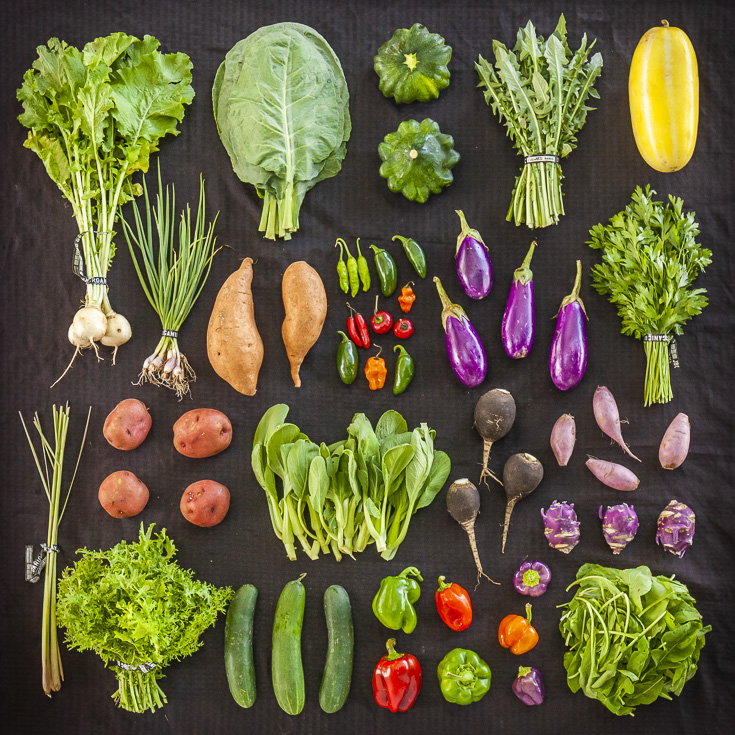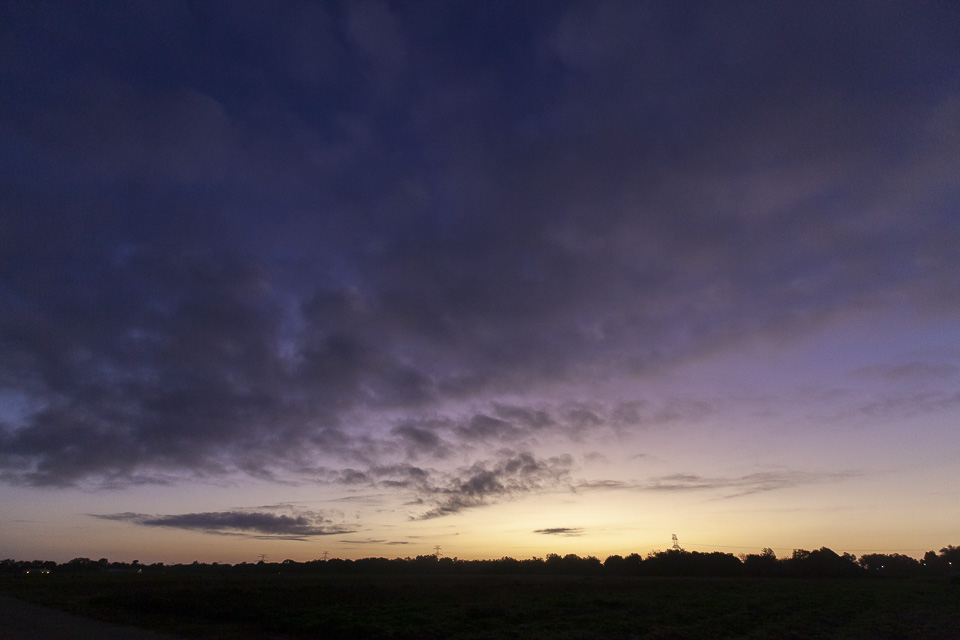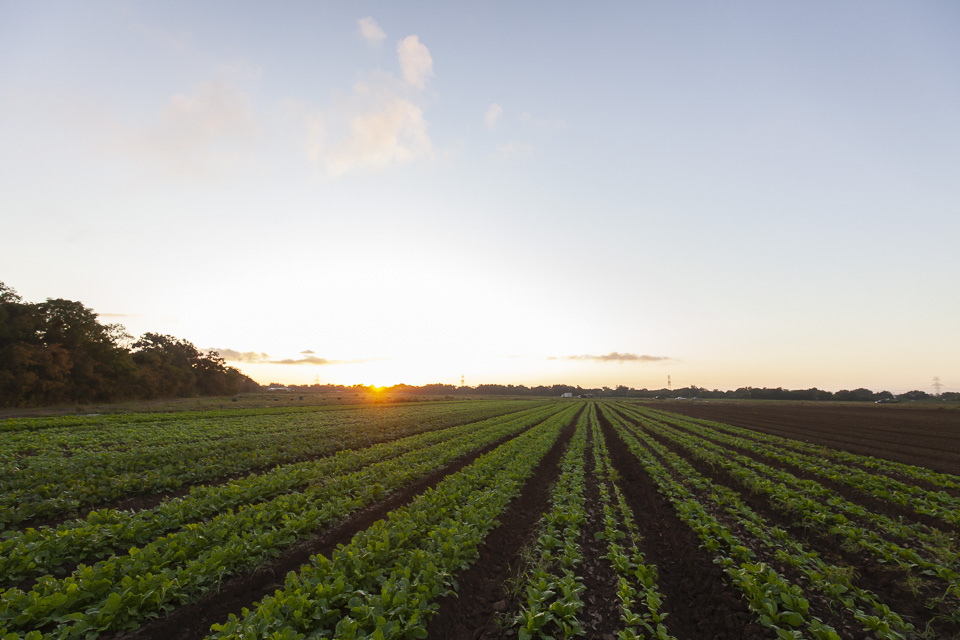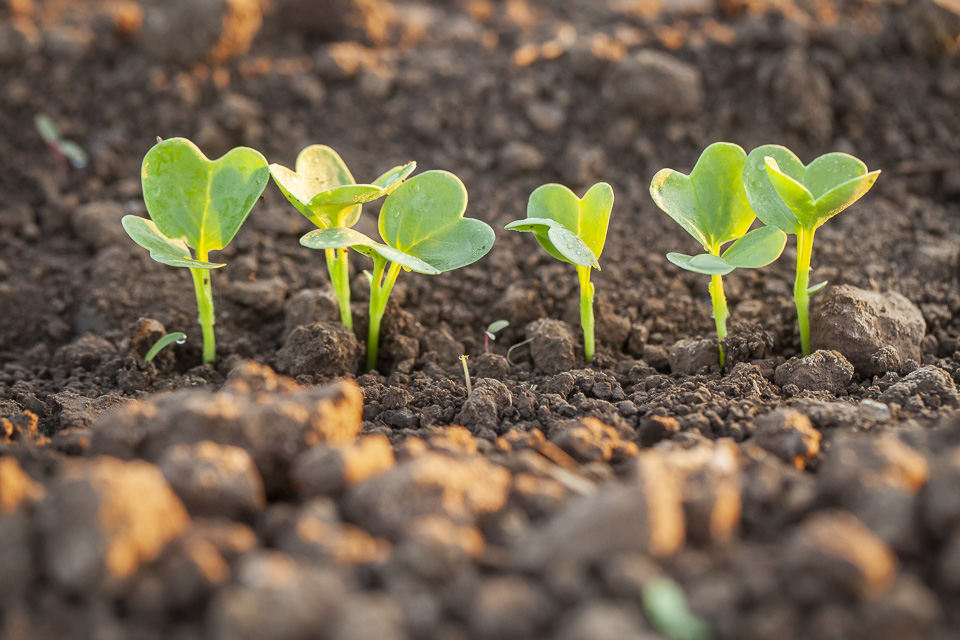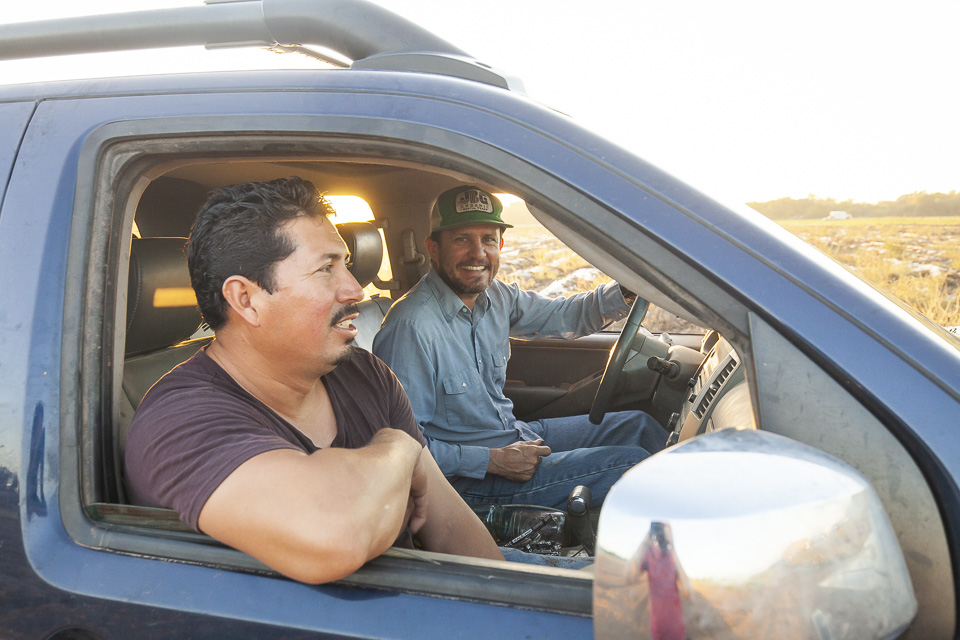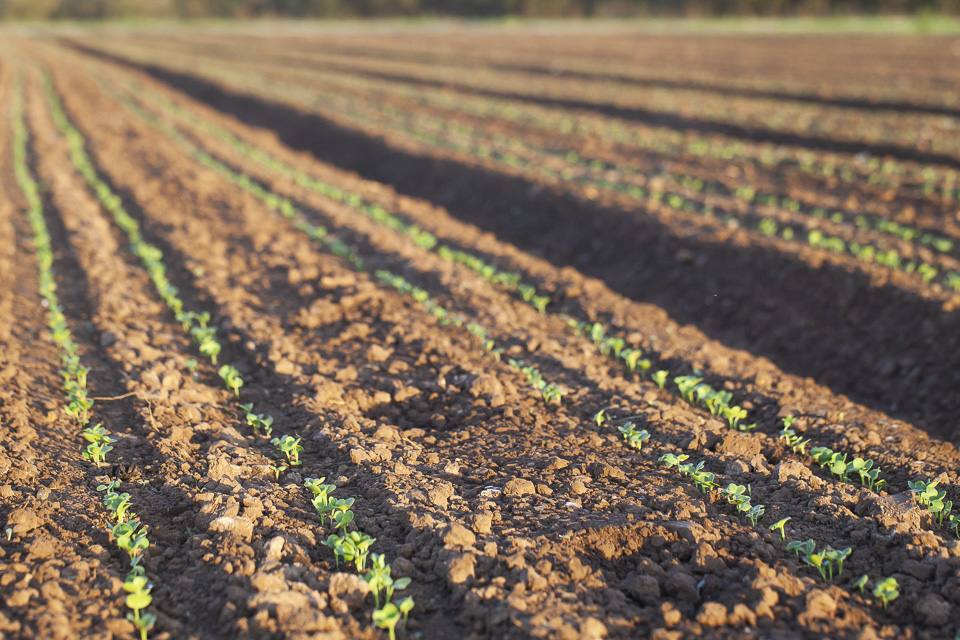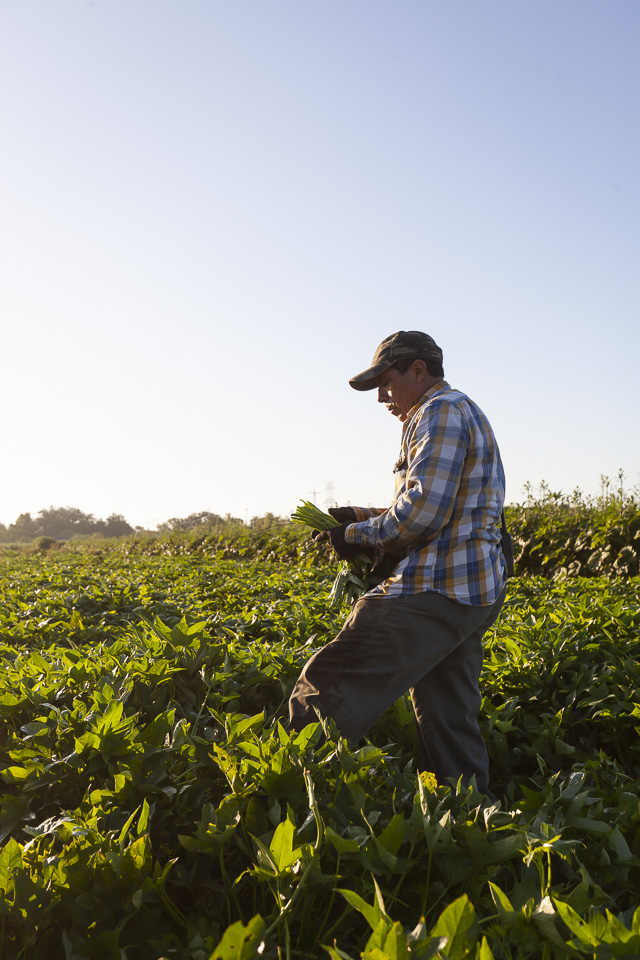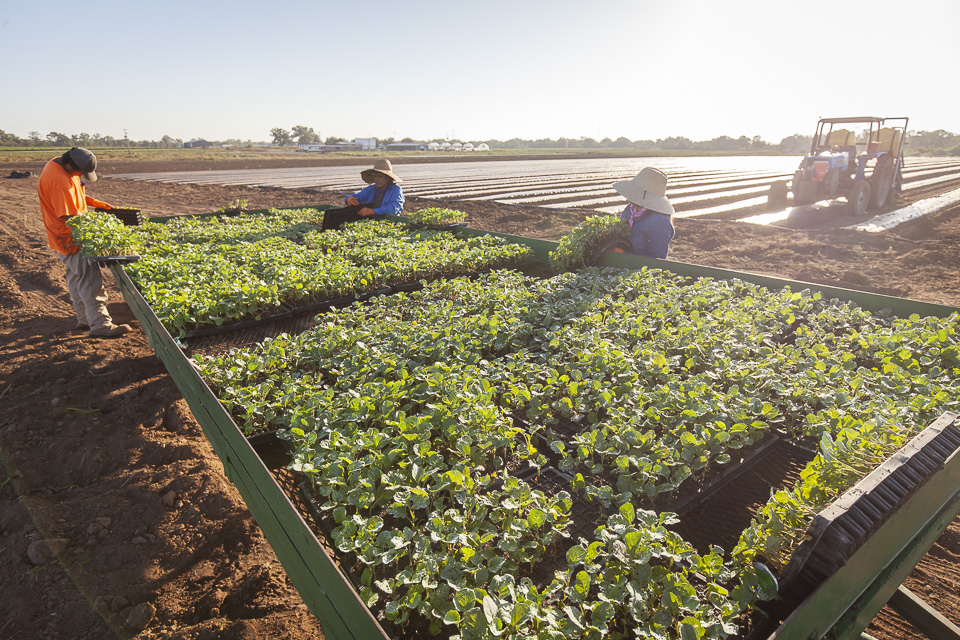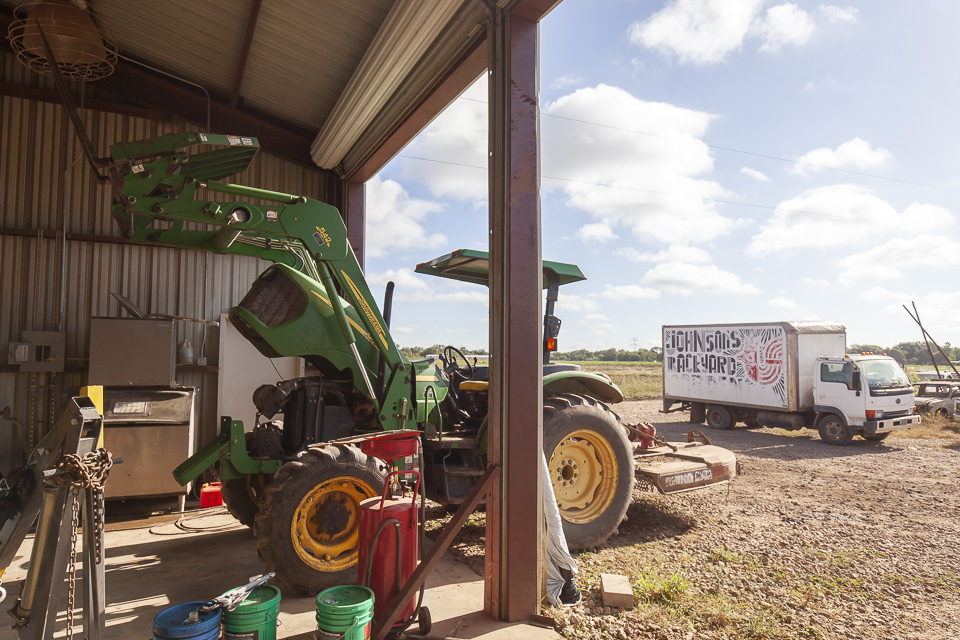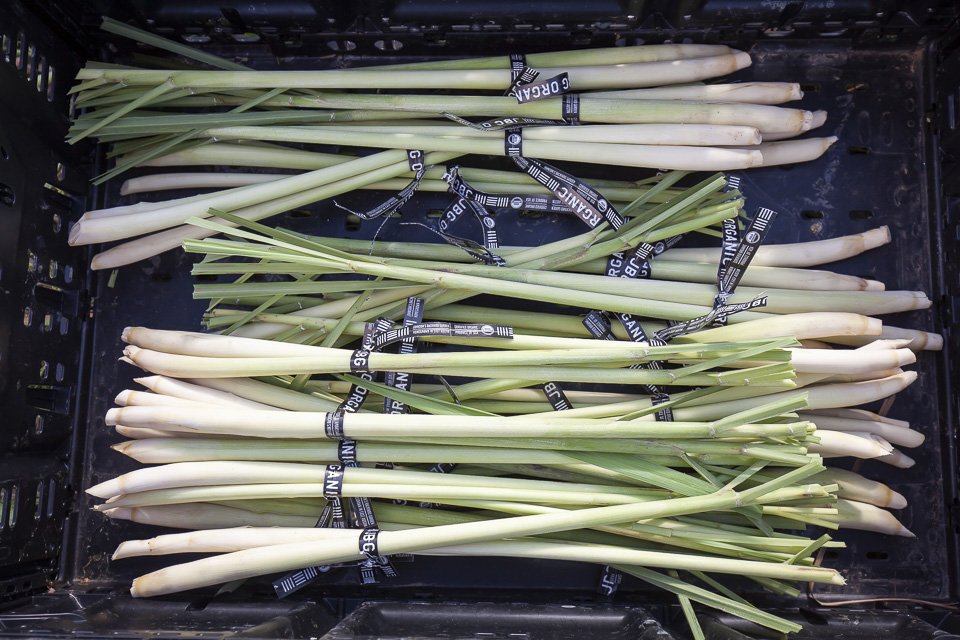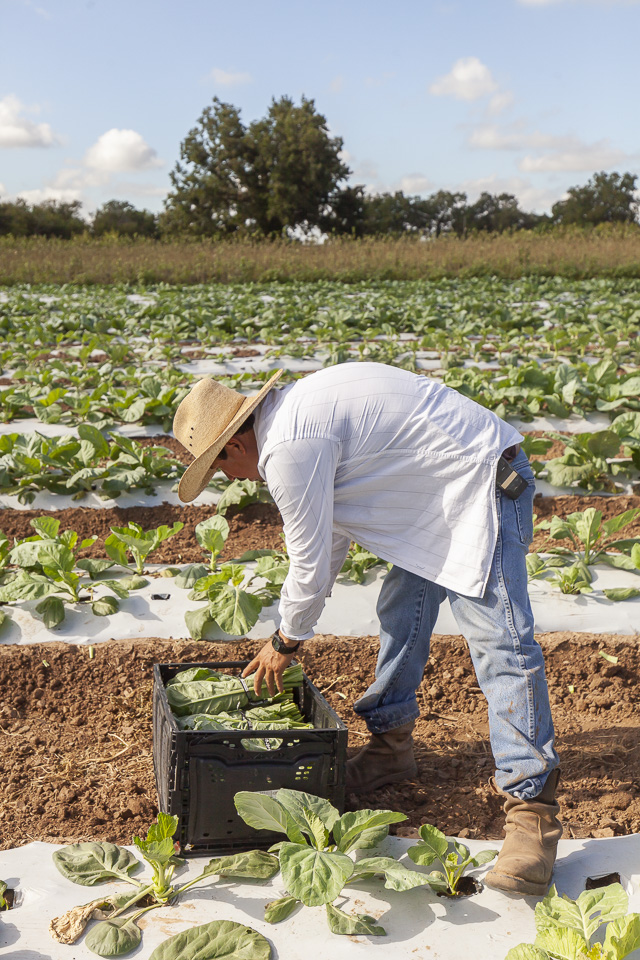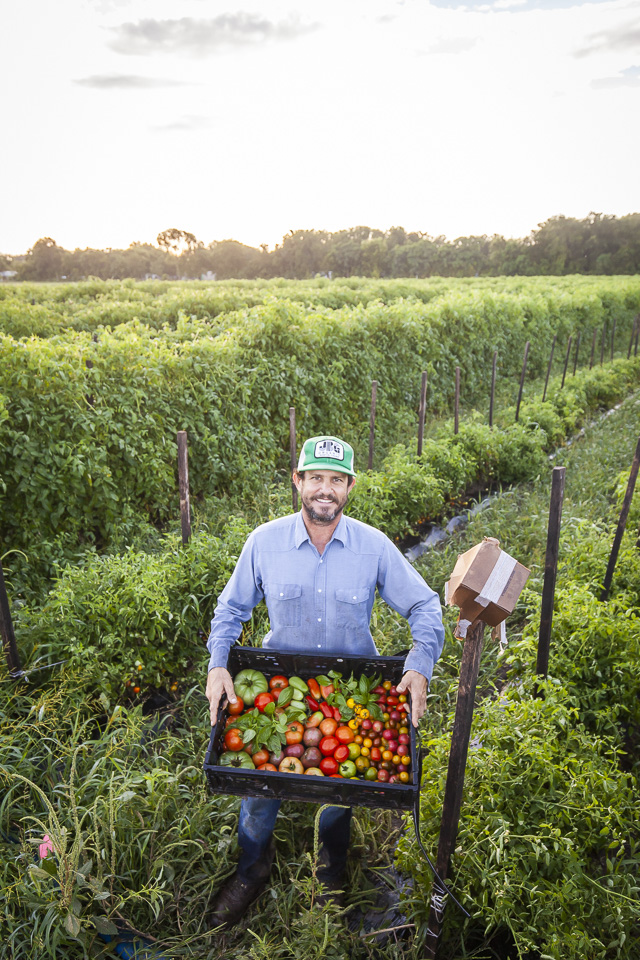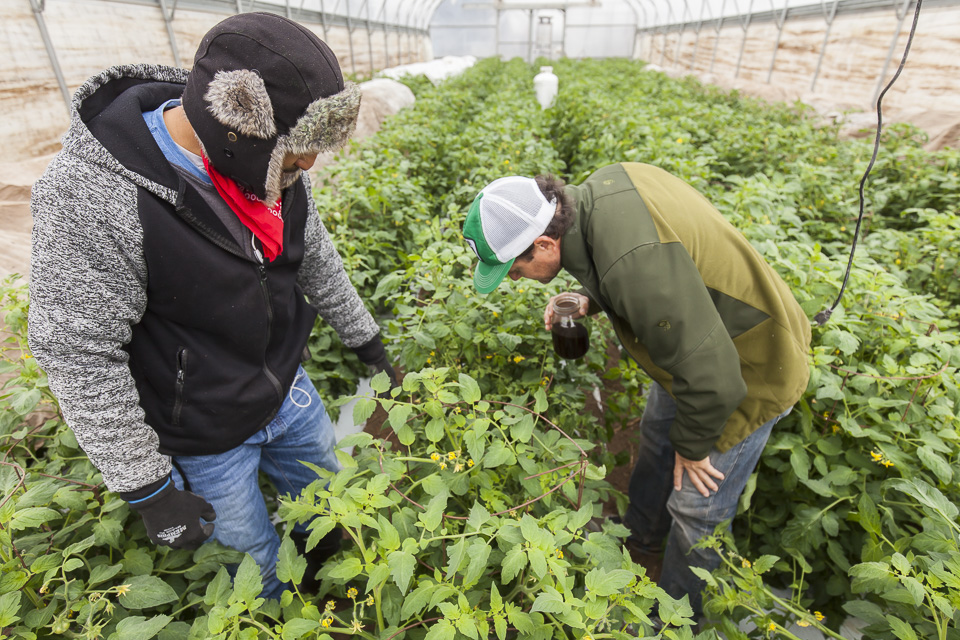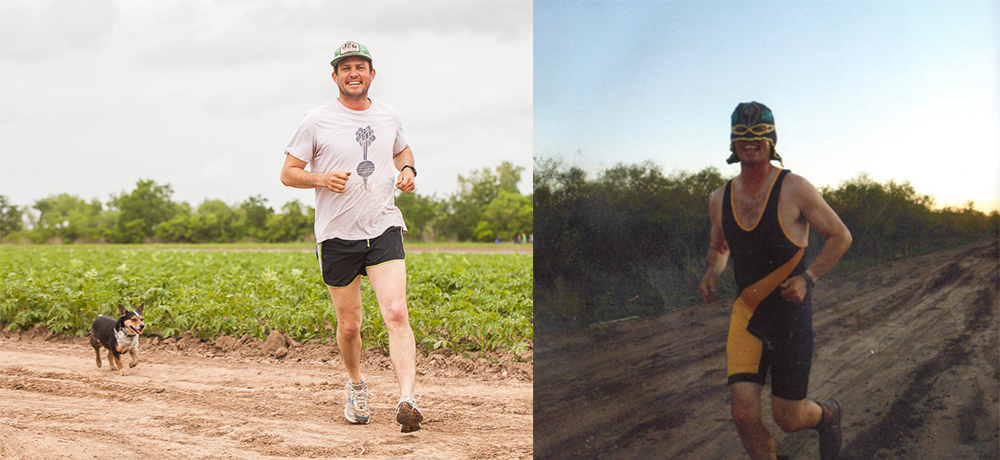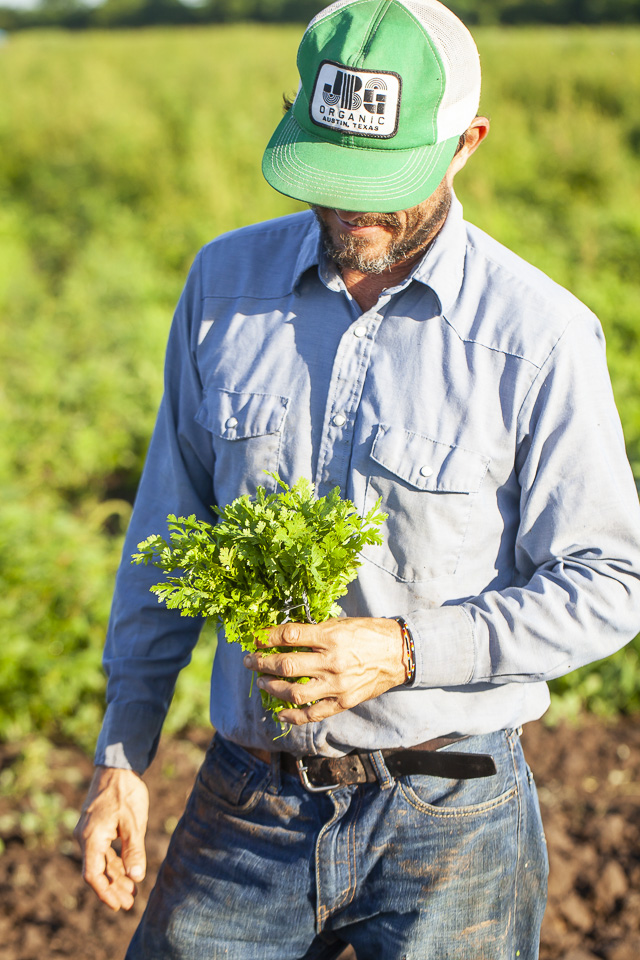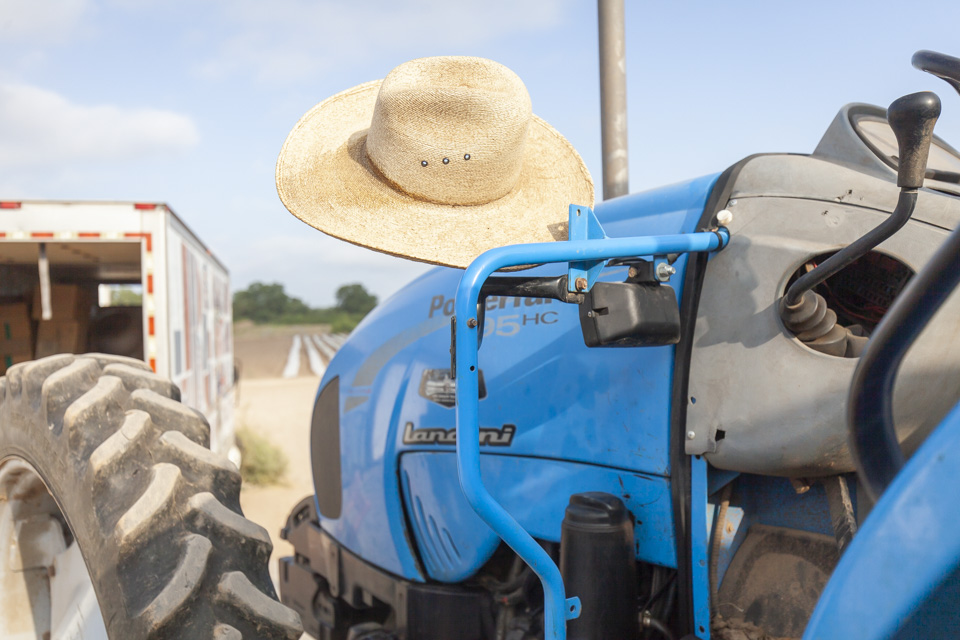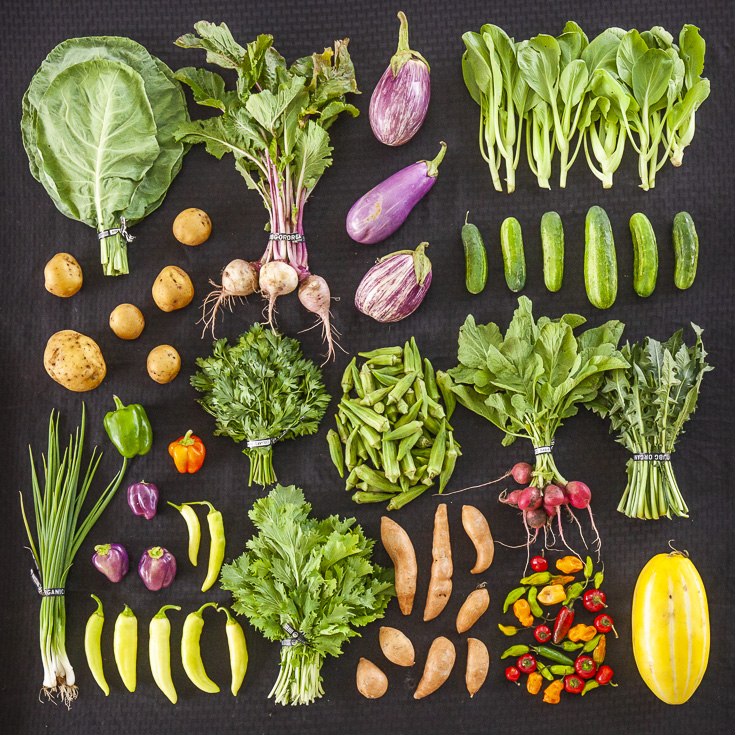
CSA BOX CONTENTS WEEK OF SEPT 2ND
09/02/19 — Scott
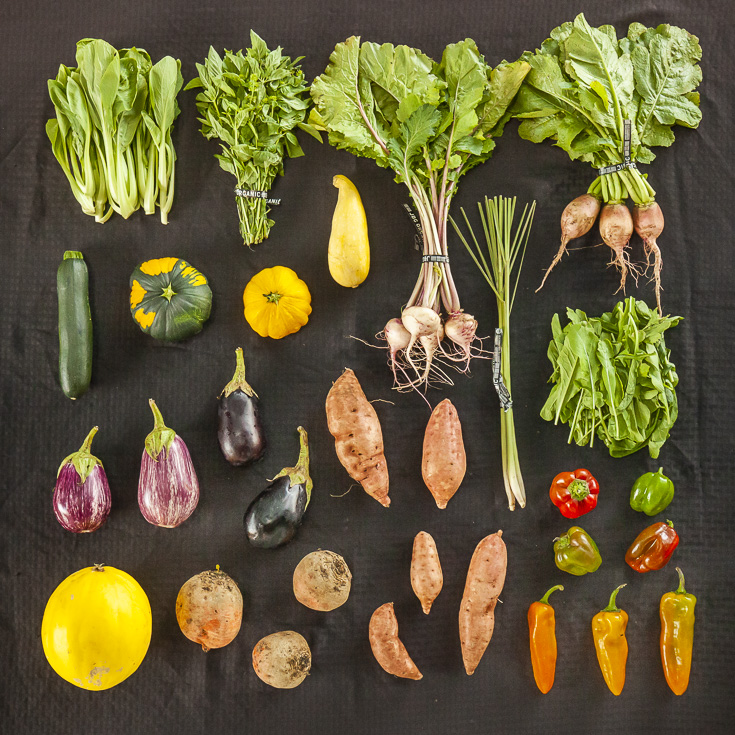 CSA Box Contents Week of Sept 2nd
CSA Box Contents Week of Sept 2nd
Large Box
Beets
Bok Choy
Carrots
Cucumber
Eggplant
Greens, Sweet Potato
Herb, Dry
Melon, Farmers Choice
Pepper, Hot Medley
Potato, Sweet
Radish
Squash, Farmer's Choice
Turnip, White Japanese
Beets
Bok Choy
Carrots
Cucumber
Eggplant
Greens, Sweet Potato
Herb, Dry
Melon, Farmers Choice
Pepper, Hot Medley
Potato, Sweet
Radish
Squash, Farmer's Choice
Turnip, White Japanese
Medium Box
Beets
Cucumber
Eggplant
Greens, Sweet Potato
Herb, Dry
Melon, Farmers Choice
Pepper, Sweet
Potato, Sweet
Squash, Farmer's Choice
Turnip, White Japanese
Beets
Cucumber
Eggplant
Greens, Sweet Potato
Herb, Dry
Melon, Farmers Choice
Pepper, Sweet
Potato, Sweet
Squash, Farmer's Choice
Turnip, White Japanese
Small Box
Cucumber
Eggplant
Greens, Sweet Potato
Pepper, Sweet
Potato
Radish
Squash, Farmer's Choice
Cucumber
Eggplant
Greens, Sweet Potato
Pepper, Sweet
Potato
Radish
Squash, Farmer's Choice
Individual Box
Bok Choy
Cucumber
Eggplant
Potato
Squash, Farmer's Choice
Bok Choy
Cucumber
Eggplant
Potato
Squash, Farmer's Choice
CSA BOX CONTENTS WEEK OF SEPT 2ND
09/03/19 — Scott
 CSA Box Contents Week of Sept 2nd
CSA Box Contents Week of Sept 2nd
Beet, Golden
Bok Choy
Carrots
Cucumber
Eggplant
Greens, Arugula
Herb, Dry
Melon, Farmers Choice
Pepper, Sweet
Potato, Sweet
Radish
Squash, Farmer's Choice
Turnip, Scarlett
SPICY, CREAMY, & MASHED SWEET TATERS
09/05/19 — Ada Broussard
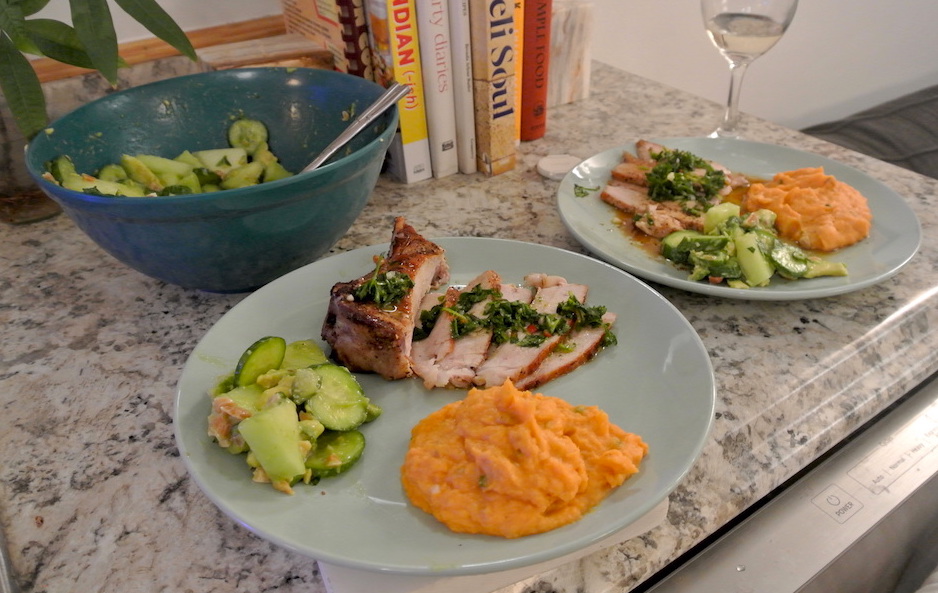 Checkout this colorful and seasonal meal. Photo by Heydon Hatcher
Recipe by Isaac Winburne, Documented by Heydon Hatcher
Checkout this colorful and seasonal meal. Photo by Heydon Hatcher
Recipe by Isaac Winburne, Documented by Heydon Hatcher
‘Twas a crazy week here in our house, so when we opened up our box of veggies to discover a cornucopia of autumnal veggies that hint at impending cooler weather, we couldn’t help but salivate at the thought of sweet, creamy mashed potatoes. Since summer crops like hot peppers still abound, we obviously and probably not surprisingly spiced up these ‘taters. We paired this velvety side with some chimichurri covered pork chops, a spicy melon-y salad, and invited some pals over. It was a fun and yum time.
Ingredients
- 6 or 7 small to medium sweet potatoes
- Salt and pepper
- 1 serrano
- 1 jalapeno
- 2 cloves of garlic
- 2 shallots
- 2 sticks of unsalted butter
- 4-5 oz of good quality half and half
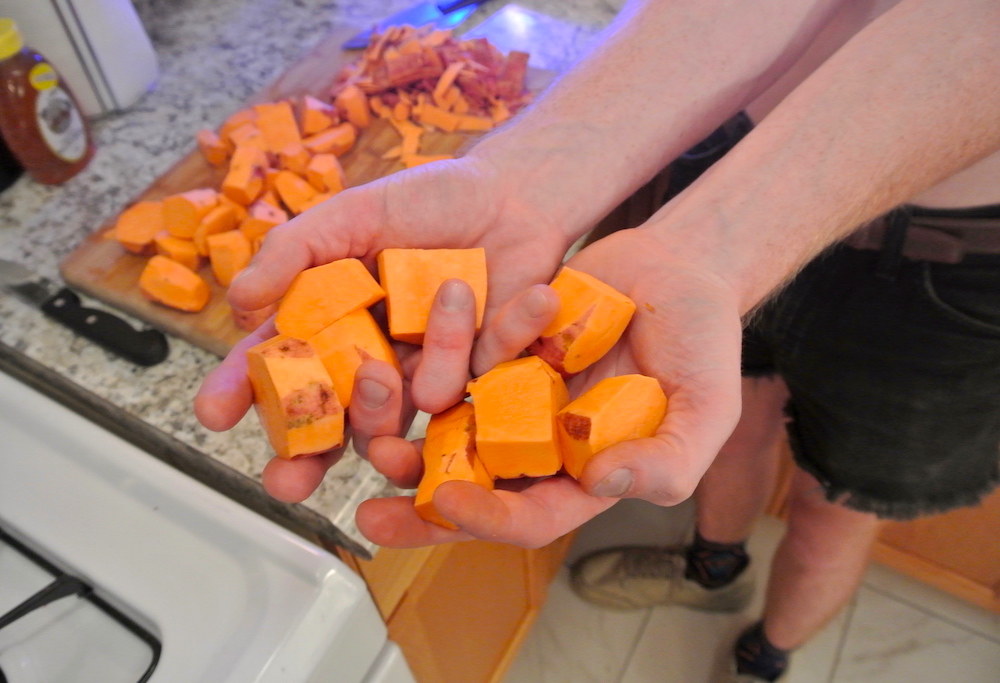 Photo by Heydon Hatcher.
Photo by Heydon Hatcher.
Skin or peel the sweet potatoes and cut into quarters (they will boil faster this way). Put potatoes into a pot and boil for half an hour. When potatoes hit the 20-minute mark of boiling, finely chop shallots, serrano, jalapeno, and garlic. Put these ingredients (sans garlic) in a skillet on low/medium heat with a half-stick of butter. Salt and pepper this mixture. Add garlic 1 minute after shallots and peppers. Cook down for 3 to 5 minutes.
Drain potatoes and keep a little water in the pot. Add one and a half sticks of butter in inch chunks and 10-12 grinds of salt and pepper.
Mix skillet contents and all buttery juices with sweet potatoes. Stir, mix, and mash those potatoes, peppers, alliums around assiduously. Salt and pepper this liberally, about 8 to 10 full grinds.
Pour half and half (we used Mill King) in the pot whilst thoroughly stirring and mashing on very low heat. Add 6-8 salt grinds. Turn on “Stir It Up” by Bob Marley for stirring inspiration. Let the mash sit with the lid on for a minute or two after reaching the consistency you prefer, stir a little more and taste. Season as needed, and voila! Spicy taters for your enjoyment. Let dreams of fall lull you into a potato coma. **Serves about 6 folks.
FIRST FRIDAY STAFF PICKS: SEPTEMBER 2019 EDITION
09/06/19 — Ada Broussard
We think that our staff is the best in the business (okay, okay, we are a little biased), but the JBG family hails from all over the place and covers the gamut in talents and interests. We love sharing events, adventures, and side projects that inspire and excite our JBG-ers (food-related or not) with the community. Check out the staff-curated list of favorites below!
![]()
My other pick is Club Home Made! I was excited to see this little bit of press that came out about our fall classes a couple weeks ago. Check us out if you haven't already!
![]() Pink - 60" x 40" - Watercolor on paper by Jan Heaton
Pink - 60" x 40" - Watercolor on paper by Jan Heaton
If you live in Austin and want to learn more about the art scene and get more involved I would recommend a few things.
Very shortly my interview with Chris Cowden the executive director of Women & Their Work with be released. September 12th from 7-10 they are having their Red Dot Art Spree which is a fundraising event that will feature over 150 works by some of the best contemporary artists in Texas, all priced $750 and below, and tax-free. There will also be a silent auction. Learn more
![]() Fingerling Sweet Potatoes. Photo by Brenton.
Fingerling Sweet Potatoes. Photo by Brenton.
![]() So much fun vintage! Photo taken from the Loyal Vintage Instagram.
So much fun vintage! Photo taken from the Loyal Vintage Instagram.
![]() Photos by Heydon Hatcher.
Photos by Heydon Hatcher.
![]() Checkout Andrew's tunes on Spotify. Perfect music for that slow stretch or study session, and general groove sessions.
Checkout Andrew's tunes on Spotify. Perfect music for that slow stretch or study session, and general groove sessions.
Ada (Blog Writer)
I laughed out loud when I saw this picture on Instagram. The caption reads, "No one planted it. but there it is, all the same. A rogue tomato is growing on a piling in the water around Brooklyn Bridge Park...." There's an entire NY Times story about it. This mysterious tomato plant seems a little less mysterious to me, because we have rogue vegetables growing ALL OVER the place at Hergotz. One time a huge bins of melons got run over in the parking lot. Weeks later, there were hundreds of (edible) watermelon sprouts growing out of the parking lot gravel. We currently have a few rogue tomato plants (with fruit) growing on the small grassy patches next to our cooler, and we've had a comically productive butternut squash plant growing in the ditch near our compost pile. I could go on, but you get the point. Drop a tomato somewhere, water + sunlight, and you might just get a tomato plant.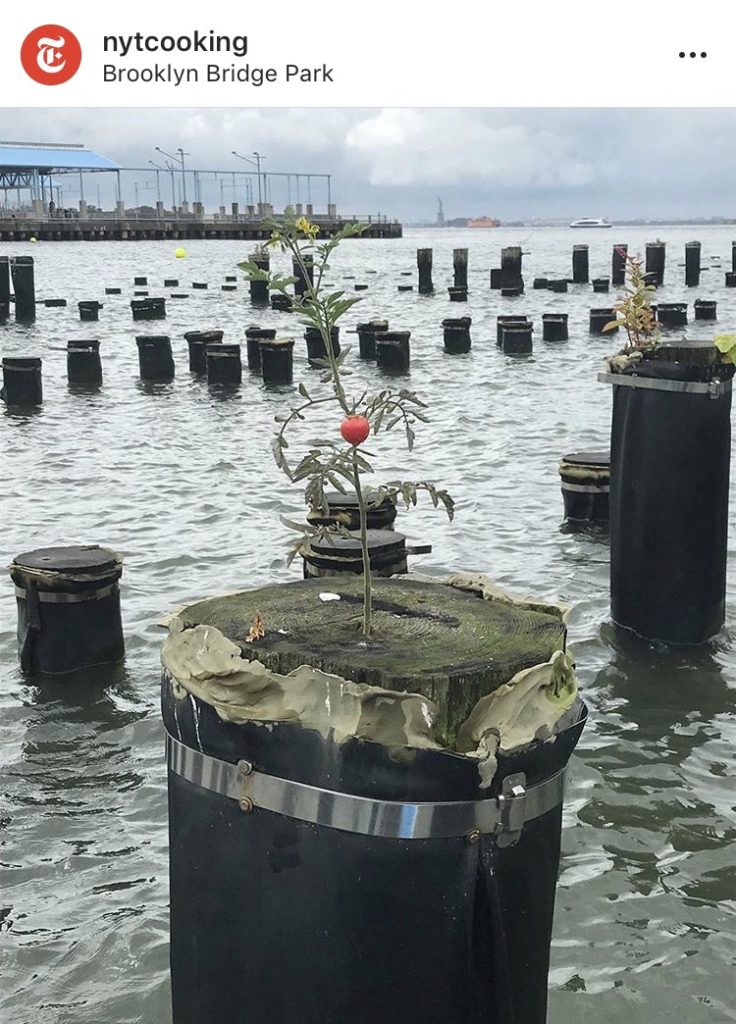
My other pick is Club Home Made! I was excited to see this little bit of press that came out about our fall classes a couple weeks ago. Check us out if you haven't already!
Scott
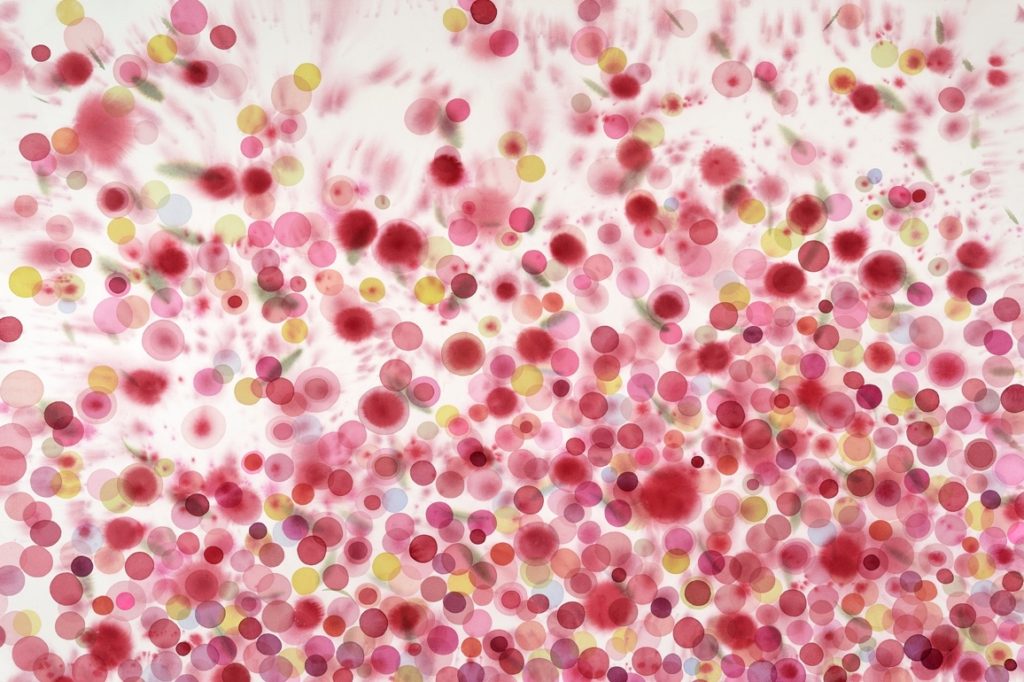 Pink - 60" x 40" - Watercolor on paper by Jan Heaton
Pink - 60" x 40" - Watercolor on paper by Jan Heaton
If you live in Austin and want to learn more about the art scene and get more involved I would recommend a few things.
- -Sign up for Art Alliance Austin’s weekly newsletter to learn about all of the upcoming art events. Do that here.
- Check out my weekly podcast Austin Art Talk, interviewing local artists and creatives. www.austinarttalk.com You can listen directly from the website or on Apple Podcasts, Spotify, Stitcher, Google Podcasts, iHeartRADIO. Pretty much any podcast app can find it. Let me know what you think. People seem to love it. You can also follow me on Instagram @austinarttalk.
Very shortly my interview with Chris Cowden the executive director of Women & Their Work with be released. September 12th from 7-10 they are having their Red Dot Art Spree which is a fundraising event that will feature over 150 works by some of the best contemporary artists in Texas, all priced $750 and below, and tax-free. There will also be a silent auction. Learn more
Faith (CSA Coordinator)
I've been devouring the Area X trilogy. (More on that here.)Brenton
I've been really into these fingerling sweet potatoes that we harvested this week. I very simply roasted some this week and they were awesome. (Here is a recipe for simple roasted fingerling sweet potatoes like Brenton made.)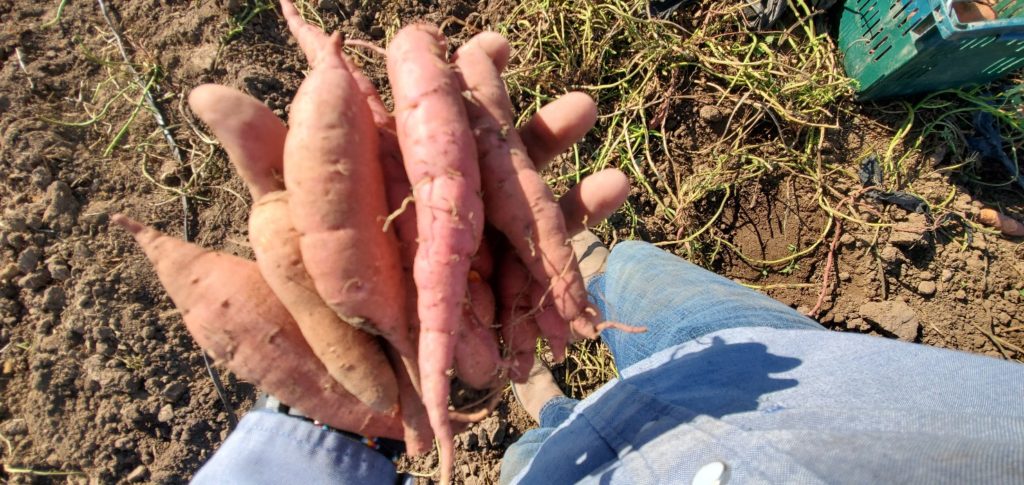 Fingerling Sweet Potatoes. Photo by Brenton.
Fingerling Sweet Potatoes. Photo by Brenton.
Megan (Recipe Developer)
This month I'm into staying home, deep cleaning, meal planning, cooking, going to bed early and waking up early for yoga, finishing my book (Liar's Club by Mary Karr), and shooting a bunch of fall inventory for my vintage shop. After traveling every weekend in August, I am so dang excited to home-body it up and take care of business, mind, and body. So much fun vintage! Photo taken from the Loyal Vintage Instagram.
So much fun vintage! Photo taken from the Loyal Vintage Instagram.
Heydon (Recipe Developer)
I had the immense privilege of attending the Auburn opening game at the dazzling and very air-conditioned AT&T Stadium, otherwise known as Jerry World, with my boyfriend and some family over the weekend. My family is a group of unremitting and die-hard Auburn fans. WAR EAGLE. The matchup was against Oregon, and the last time we faced the Ducks was in the 2011 National Championship when Cam Newton was at the helm of our offense. Auburn won a national championship that year, so we were excited to see a re-match of this cross-country rivalry. It was an abysmal game, for the most part, Auburn looking adrift, until a sensational comeback led by true freshman, Bo Nix, in the final quarter. We lost our minds and I lost my voice. Thanks for the good times, Dallas. Can't wait to see what Bo has in store for this season... should be a stressful and very fun one. College football is back, baby! Photos by Heydon Hatcher.
Photos by Heydon Hatcher.
Nao (Farmers Market Crew)
I'm Nao Ward. I'm a happy market staff at Sunset Valley, and am PSYCHED about starting a position with AmeriCorps' Bicycle Outreach Program on September 3!Andrew (CSA Packing Manager)
I've been enjoying focusing on my music lately. I'm playing tonight, Friday 9/6 at Spokesman for Imaginary Stereo and will have a couple of cassettes coming out this month. You can also give my groovy tunes a listen on my Spotify. Checkout Andrew's tunes on Spotify. Perfect music for that slow stretch or study session, and general groove sessions.
Checkout Andrew's tunes on Spotify. Perfect music for that slow stretch or study session, and general groove sessions.
PHOTOS FROM THE FARM: 9.6.19
09/06/19 — Ada Broussard
Farm photographer Scott Gordon visited us under the Mueller hanger this week at the Sunday Mueller Farmers' Market. (BTW, did you know they also have a weekday, Wednesday market at the same location?). Farmers' markets are not only an important part of our businesses financially, but they also make up a huge part of what is fun about growing food for the community. We absolutely love setting up at markets, getting to know new customers, visiting with old customers, and sharing recipes. Every week, it's like a reunion with the other vendors, and the whole experience truly heartwarming. With multiple Saturday, Sunday, and Wednesday farmers market options in Austin, there is really no excuse to not go. Each market has its own flavor, and each one is oh-so-special. Protip: Choose to pickup your CSA box at one of our farmers' markets and you can swap out any item in your box with something you'd prefer from our market stand. To see the full list of markets we attend, checkout this page.
![]() We usually setup under the old airport hanger at the Mueller Farmers' Market. Have you seen us there? (P.S. - Checkout our CSA table to the right. Mueller is one of our most popular CSA pickup spots!) Photo by Scott David Gordon.
We usually setup under the old airport hanger at the Mueller Farmers' Market. Have you seen us there? (P.S. - Checkout our CSA table to the right. Mueller is one of our most popular CSA pickup spots!) Photo by Scott David Gordon.
![]() The unusually delicious Korean Melon. Some say it tastes like a pear, some some say an apple. But really, you've gotta taste it to know. Photo by Scott David Gordon.
The unusually delicious Korean Melon. Some say it tastes like a pear, some some say an apple. But really, you've gotta taste it to know. Photo by Scott David Gordon.
![]() The three floofiest market customers. Photo by Scott David Gordon.
The three floofiest market customers. Photo by Scott David Gordon.
![]() Bunched scarlet turnips are starting to roll in. Root, stem, and leaf is all edible. Three vegetables, in one. Photo by Scott David Gordon.
Bunched scarlet turnips are starting to roll in. Root, stem, and leaf is all edible. Three vegetables, in one. Photo by Scott David Gordon.
![]() A nutritionally dense tower. Photo by Scott David Gordon.
A nutritionally dense tower. Photo by Scott David Gordon.
![]() We spy a lot of reusable bags and a lot of healthy-meals to come. Thank you to all of our market customers! We love ya. Photo by Scott David Gordon.
We spy a lot of reusable bags and a lot of healthy-meals to come. Thank you to all of our market customers! We love ya. Photo by Scott David Gordon.
![]() Alexander getting turnips ready for CSA boxes. Photo by Scott David Gordon.
Alexander getting turnips ready for CSA boxes. Photo by Scott David Gordon.
![]() Fruits of our labor. Photo by Scott David Gordon.
Fruits of our labor. Photo by Scott David Gordon.
![]() Is it just us, or does meticulously packed produce make you happy? Photo by Scott David Gordon. Fig styling by Joyce.
Is it just us, or does meticulously packed produce make you happy? Photo by Scott David Gordon. Fig styling by Joyce.
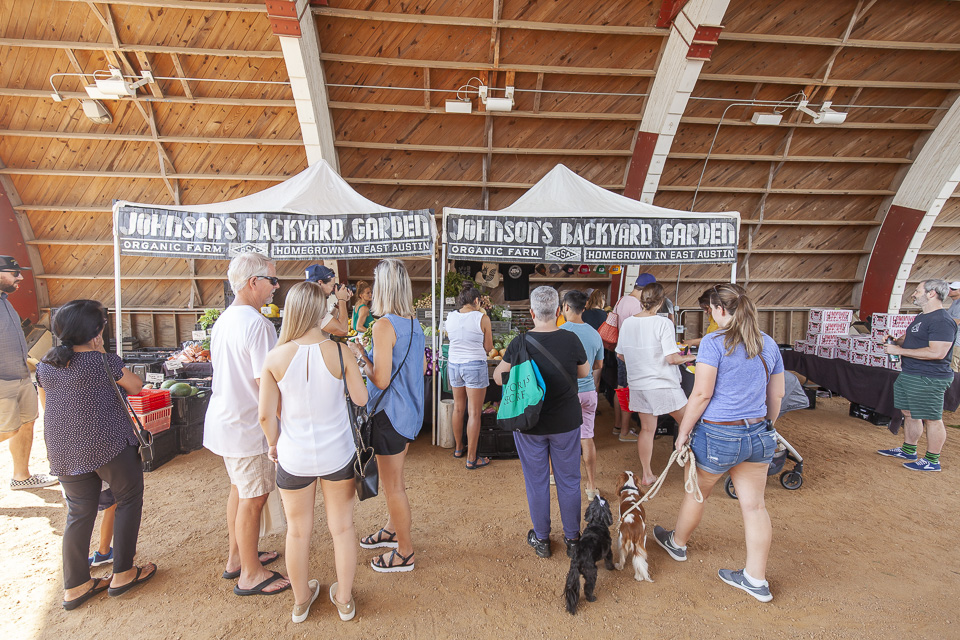 We usually setup under the old airport hanger at the Mueller Farmers' Market. Have you seen us there? (P.S. - Checkout our CSA table to the right. Mueller is one of our most popular CSA pickup spots!) Photo by Scott David Gordon.
We usually setup under the old airport hanger at the Mueller Farmers' Market. Have you seen us there? (P.S. - Checkout our CSA table to the right. Mueller is one of our most popular CSA pickup spots!) Photo by Scott David Gordon.
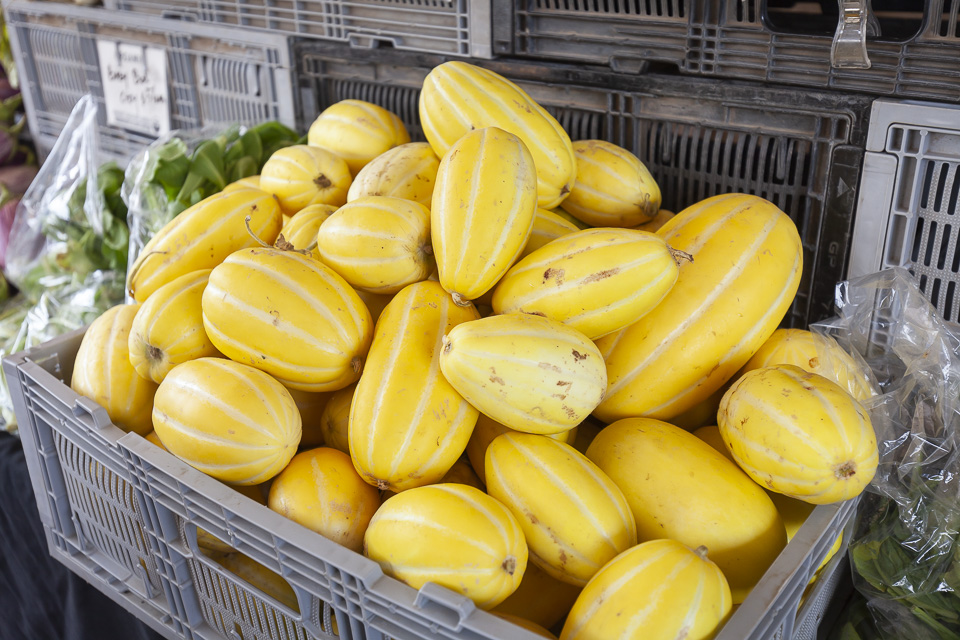 The unusually delicious Korean Melon. Some say it tastes like a pear, some some say an apple. But really, you've gotta taste it to know. Photo by Scott David Gordon.
The unusually delicious Korean Melon. Some say it tastes like a pear, some some say an apple. But really, you've gotta taste it to know. Photo by Scott David Gordon.
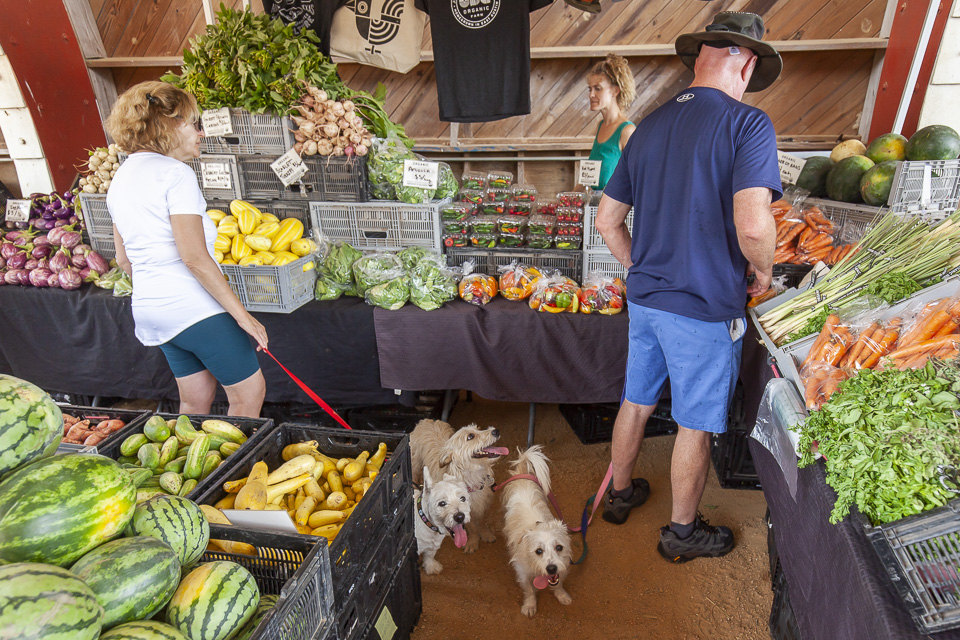 The three floofiest market customers. Photo by Scott David Gordon.
The three floofiest market customers. Photo by Scott David Gordon.
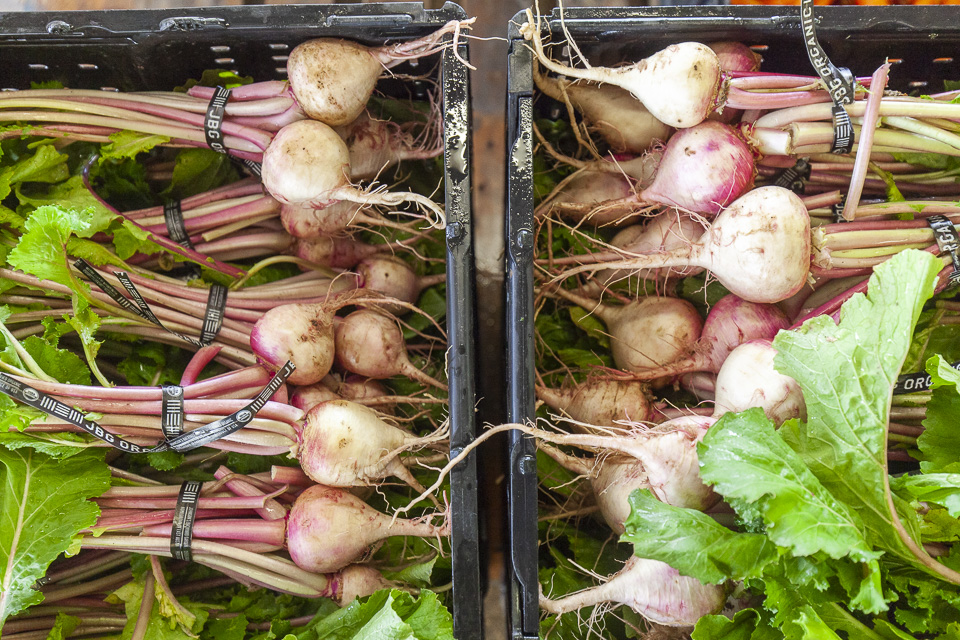 Bunched scarlet turnips are starting to roll in. Root, stem, and leaf is all edible. Three vegetables, in one. Photo by Scott David Gordon.
Bunched scarlet turnips are starting to roll in. Root, stem, and leaf is all edible. Three vegetables, in one. Photo by Scott David Gordon.
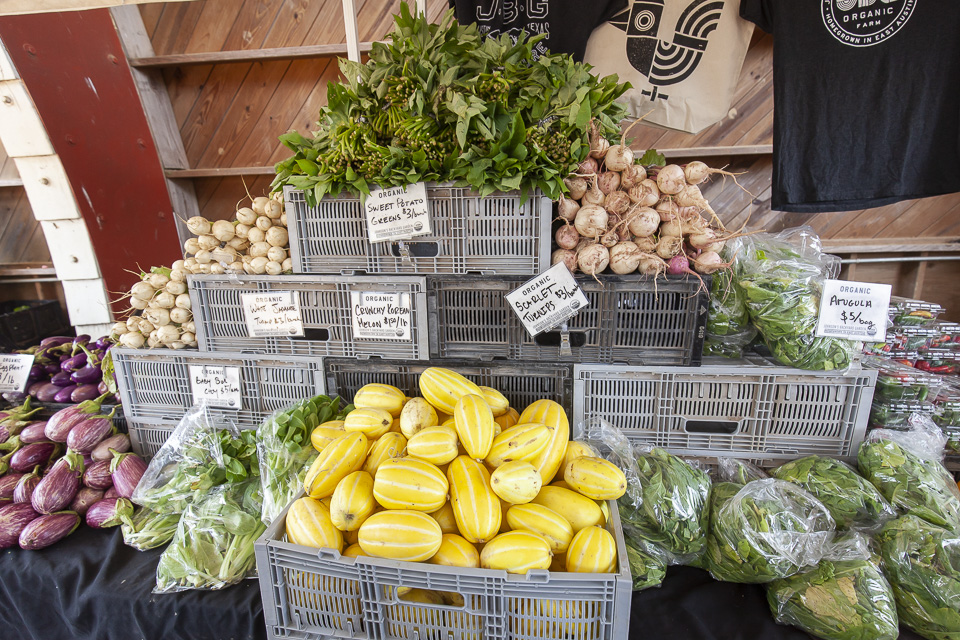 A nutritionally dense tower. Photo by Scott David Gordon.
A nutritionally dense tower. Photo by Scott David Gordon.
 We spy a lot of reusable bags and a lot of healthy-meals to come. Thank you to all of our market customers! We love ya. Photo by Scott David Gordon.
We spy a lot of reusable bags and a lot of healthy-meals to come. Thank you to all of our market customers! We love ya. Photo by Scott David Gordon.
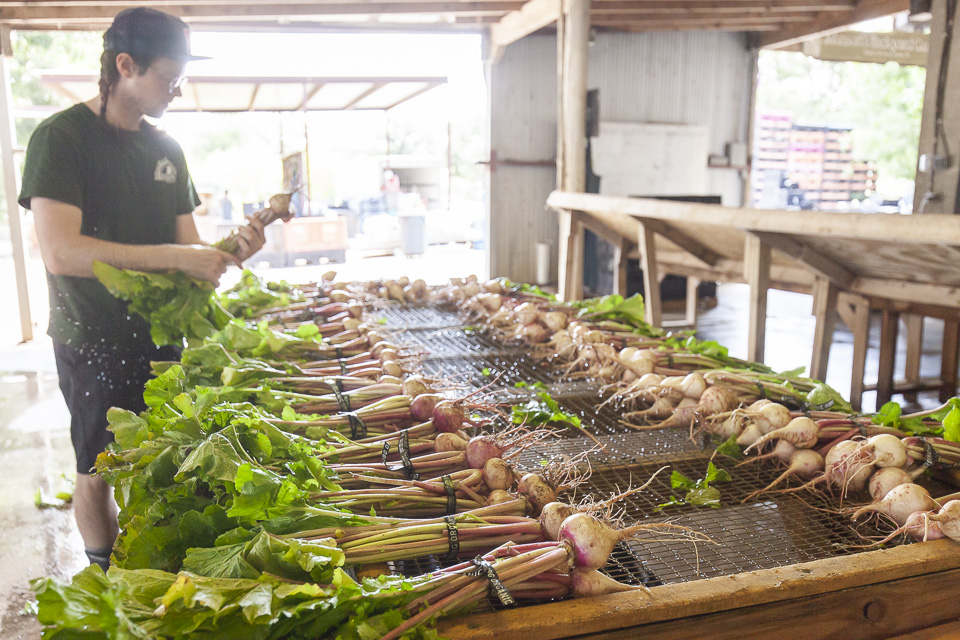 Alexander getting turnips ready for CSA boxes. Photo by Scott David Gordon.
Alexander getting turnips ready for CSA boxes. Photo by Scott David Gordon.
 Fruits of our labor. Photo by Scott David Gordon.
Fruits of our labor. Photo by Scott David Gordon.
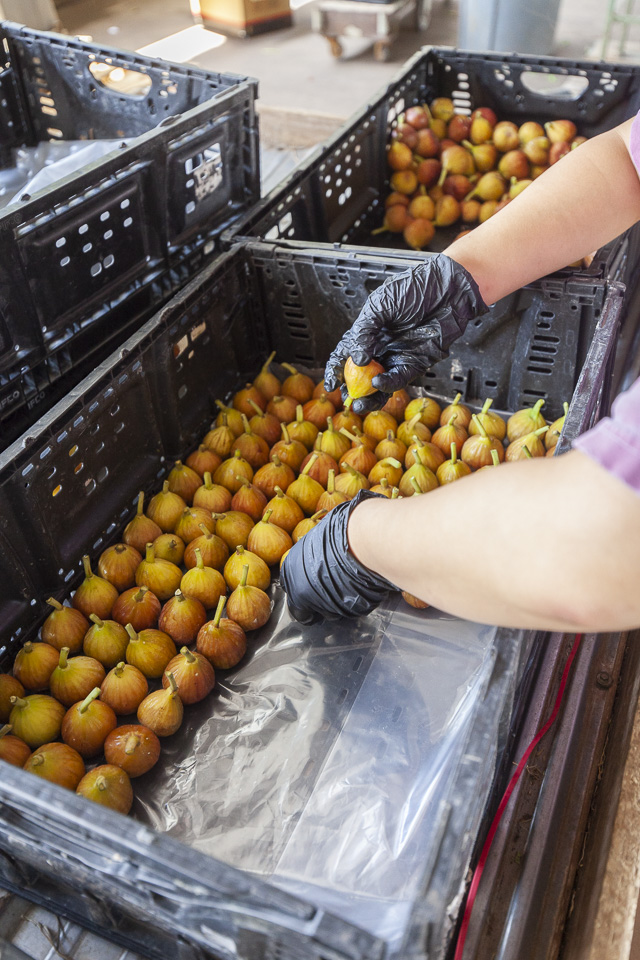 Is it just us, or does meticulously packed produce make you happy? Photo by Scott David Gordon. Fig styling by Joyce.
Is it just us, or does meticulously packed produce make you happy? Photo by Scott David Gordon. Fig styling by Joyce.
FARM ANNOUNCEMENTS
09/06/19 — Ada Broussard
This week we’re checking in with some quick announcements that we want to be sure you know about. Also! Be sure to checkout this month's installment of First Friday Staff Picks where we share the vibrant collection of events and recipes that make our staff tick.
![]() JBG Rainbow Carrots. Photo by Scott Gordon.
JBG Rainbow Carrots. Photo by Scott Gordon.
Back by popular demand, we’re now selling JBG Juice Boxes. And to be clear, we’re not talking about the kid-sized drinks with plastic straws. No! These are adult-sized produce boxes, chock-full of seasonal vegetables, especially picked for the home-juicer. Right now, the juice boxes feature carrots, beets, lemongrass, cucumbers, herbs and a couple spicy peppers to really get things going. Once fall crops start to roll in, the cucumbers will be replaced with dark-leafy greens like kale, and we’ll start to include tops to the beets (also juice-able). If you juice at home, you know that it takes a lot of vegetables to make your morning bevy, day after day. We hope this juice box is the local and seasonal answer to your needs. And if you haven’t tried juicing- here’s your chance. Here is a juicer that we’ve used in the Hergotz break room with great success, and if you’re feeling adventurous, it looks like there are lots of juicer peddlers on the Austin Craigslist. If you’re on the go and looking for a quick nutritional boost, there might not be any better way to get your daily vitamins and minerals than to drink them. Reminder that farm-fresh vegetables are usually healthier than their grocery-store counterparts… they’re closer to their harvest date, and spend less time in storage and transit, where the nutritional content of veggies can degrade. Here is a gingered-carrot and beet juice recipe that, believe it or not, doesn’t even require a juicer.
If you want a juice box, just email Faith (farm@jbgorganic.com) and let her know where you would like to pickup your juice box. There is a list of pickup options here. The cost is $15 for CSA members, and $20 for non-members. CSA Members: If you’re a home delivery customer, just let Faith know you’d like to get a JBG Juice Box delivered with CSA share. How many times do you think we said the word “juice” in this announcement? Fourteen. Now get that get that juice box!
![]()
Exhibition Title: 7th Annual Farmer as Artist Show Where: Prizer Arts & Letters, 2023 E. Cesar Chavez, Austin, TX 78702 Opening Reception: Saturday, September 7th, 6pm to 9pm Exhibition Dates: September 7th, 2019 – September 29th, 2019
![]() Work from the 2017 Farmer as Artist show. Photo by Scott David Gordon.
Work from the 2017 Farmer as Artist show. Photo by Scott David Gordon.
![]() This photo by Drew Johnson, Brenton's son, will be on display at this year's exhibit.
This photo by Drew Johnson, Brenton's son, will be on display at this year's exhibit.
![]() JBG Volunteers helping sort carrots. Photo by Scott Gordon.
JBG Volunteers helping sort carrots. Photo by Scott Gordon.
If you can spare the time, we invite you to join us in the greenhouse for a relaxing day of seeding!! Per usual, volunteers are thanked with a huge bounty of organic vegetables (don't forget to bring your reusable bag!).
Choose our volunteer day by filling out this quick google form. Unavailable but know someone who might be interested in this unique volunteer opportunity? Please send them our way! Questions? Shoot a separate email to volunteer@jbgorganic.com and our volunteer coordinator, Angie will get back to you. Thanks in advance for all your helping hands!
![]() Volunteers helping Gianna, our greenhouse manager, mix soil and fill flats. Photo by Scott David Gordon
Volunteers helping Gianna, our greenhouse manager, mix soil and fill flats. Photo by Scott David Gordon
1. JBG Juice Boxes
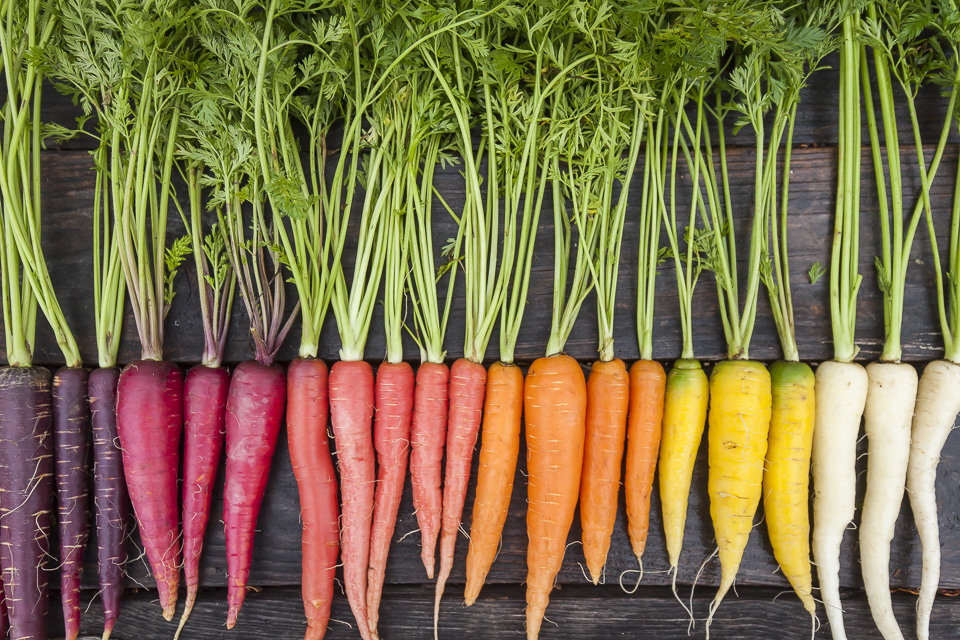 JBG Rainbow Carrots. Photo by Scott Gordon.
JBG Rainbow Carrots. Photo by Scott Gordon.
Back by popular demand, we’re now selling JBG Juice Boxes. And to be clear, we’re not talking about the kid-sized drinks with plastic straws. No! These are adult-sized produce boxes, chock-full of seasonal vegetables, especially picked for the home-juicer. Right now, the juice boxes feature carrots, beets, lemongrass, cucumbers, herbs and a couple spicy peppers to really get things going. Once fall crops start to roll in, the cucumbers will be replaced with dark-leafy greens like kale, and we’ll start to include tops to the beets (also juice-able). If you juice at home, you know that it takes a lot of vegetables to make your morning bevy, day after day. We hope this juice box is the local and seasonal answer to your needs. And if you haven’t tried juicing- here’s your chance. Here is a juicer that we’ve used in the Hergotz break room with great success, and if you’re feeling adventurous, it looks like there are lots of juicer peddlers on the Austin Craigslist. If you’re on the go and looking for a quick nutritional boost, there might not be any better way to get your daily vitamins and minerals than to drink them. Reminder that farm-fresh vegetables are usually healthier than their grocery-store counterparts… they’re closer to their harvest date, and spend less time in storage and transit, where the nutritional content of veggies can degrade. Here is a gingered-carrot and beet juice recipe that, believe it or not, doesn’t even require a juicer.
If you want a juice box, just email Faith (farm@jbgorganic.com) and let her know where you would like to pickup your juice box. There is a list of pickup options here. The cost is $15 for CSA members, and $20 for non-members. CSA Members: If you’re a home delivery customer, just let Faith know you’d like to get a JBG Juice Box delivered with CSA share. How many times do you think we said the word “juice” in this announcement? Fourteen. Now get that get that juice box!

2. Farmer as Artist Art Opening This Saturday!
Now in its seventh year, Farmer as Artist explores the link between creativity and farming by exhibiting the artwork of Central Texas farmers. Several JBGers will be showing off their artist talent this year, in addition to participations from other local farms like: Boggy Creek Farm, Millberg Farm, Munkebo Farm, Middle Ground Farm, Farmshare Austin, Reverse Pioneers, Emadi Acres Farm, Get Well Farms, Eden East Farm, Burro Malo Farm, Ironbridge Farm and more. If you’re looking for something to do this Saturday, checkout this exhibit - it’s free and open to all. Farmers in off-farm attire… it’s something to behold!Exhibition Title: 7th Annual Farmer as Artist Show Where: Prizer Arts & Letters, 2023 E. Cesar Chavez, Austin, TX 78702 Opening Reception: Saturday, September 7th, 6pm to 9pm Exhibition Dates: September 7th, 2019 – September 29th, 2019
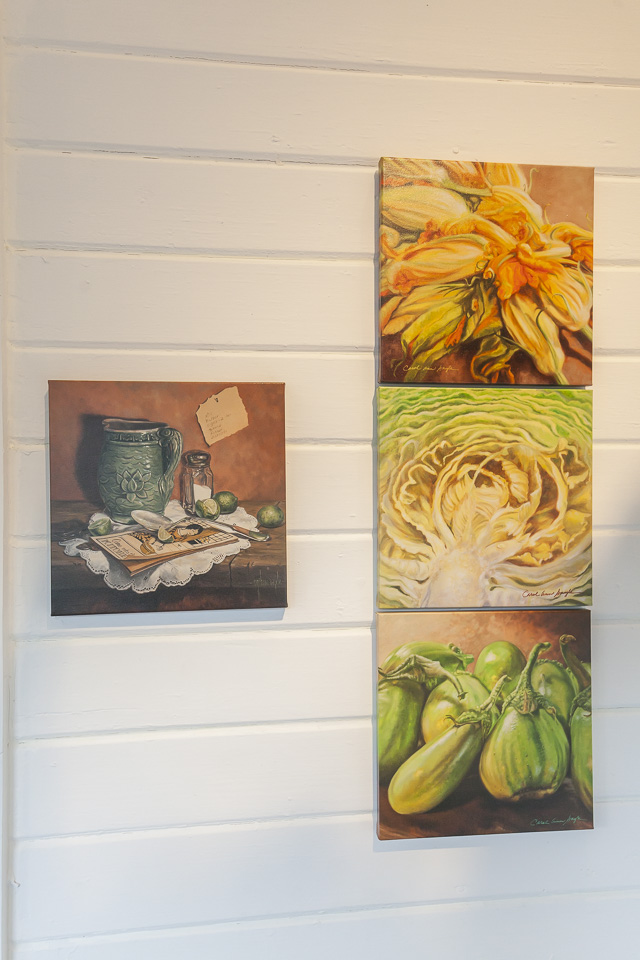 Work from the 2017 Farmer as Artist show. Photo by Scott David Gordon.
Work from the 2017 Farmer as Artist show. Photo by Scott David Gordon.
 This photo by Drew Johnson, Brenton's son, will be on display at this year's exhibit.
This photo by Drew Johnson, Brenton's son, will be on display at this year's exhibit.
3. Volunteers Needed
Our amazing staff need some volunteer help. These next couple of weeks are some of the busiest of the entire year for us, specifically in the greenhouse. We're seeding so many fall crops including brassicas like cauliflower and broccoli, lots of various lettuces and other greens, and so many onions. This week alone, we need to seed 3,000 flats of onions! That's over 384,000 individual onion seeds that have to be placed in a tiny cell of soil, by hand. Like we said... we could use your help!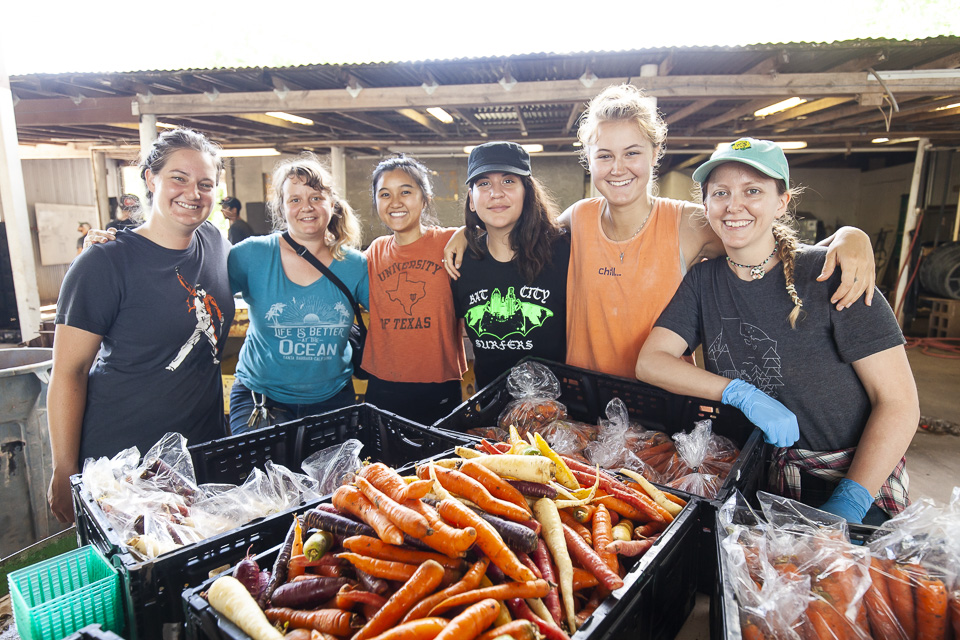 JBG Volunteers helping sort carrots. Photo by Scott Gordon.
JBG Volunteers helping sort carrots. Photo by Scott Gordon.
If you can spare the time, we invite you to join us in the greenhouse for a relaxing day of seeding!! Per usual, volunteers are thanked with a huge bounty of organic vegetables (don't forget to bring your reusable bag!).
Choose our volunteer day by filling out this quick google form. Unavailable but know someone who might be interested in this unique volunteer opportunity? Please send them our way! Questions? Shoot a separate email to volunteer@jbgorganic.com and our volunteer coordinator, Angie will get back to you. Thanks in advance for all your helping hands!
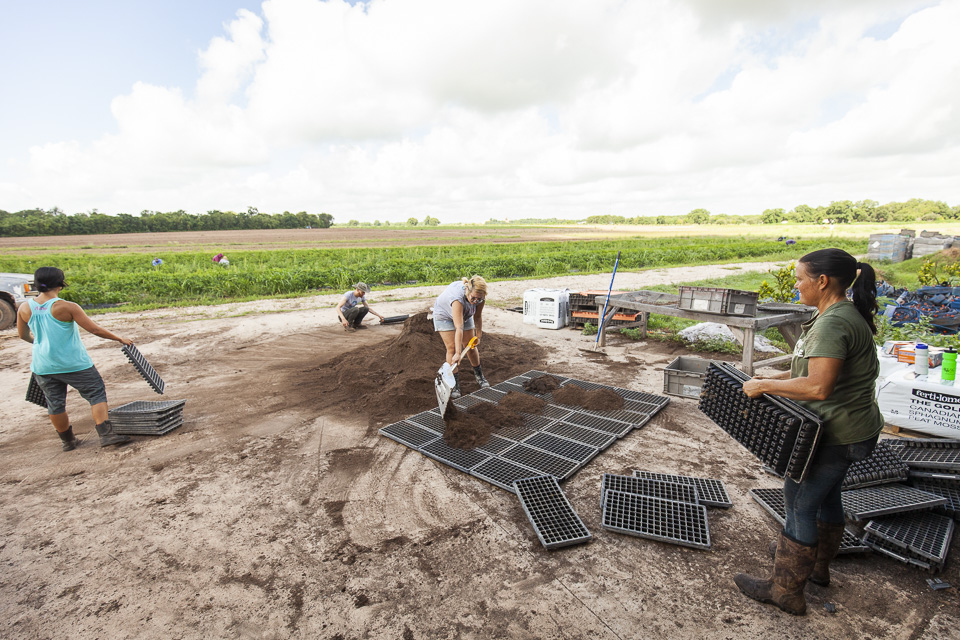 Volunteers helping Gianna, our greenhouse manager, mix soil and fill flats. Photo by Scott David Gordon
Volunteers helping Gianna, our greenhouse manager, mix soil and fill flats. Photo by Scott David GordonCSA BOX CONTENTS WEEK OF SEPT 9TH
09/09/19 — Scott
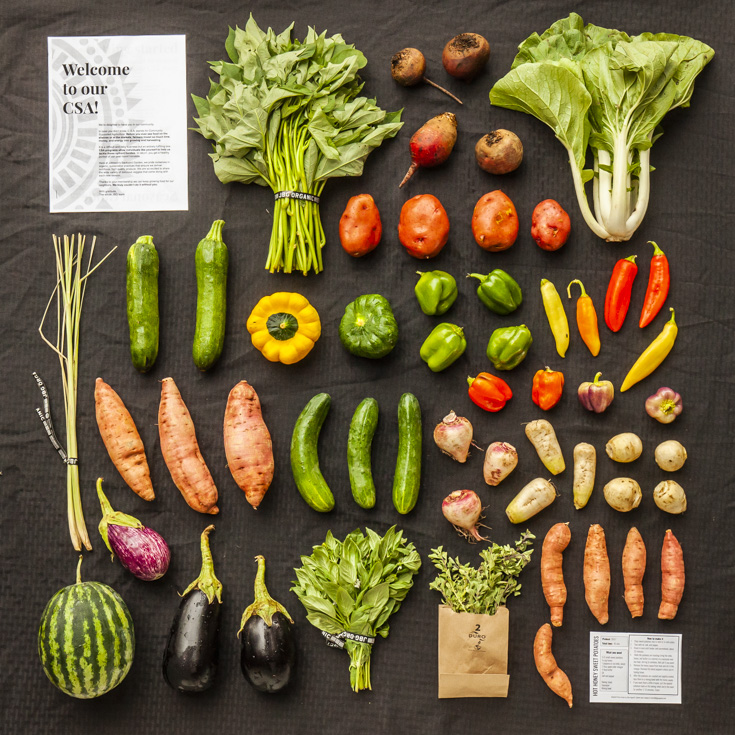 CSA Box Contents Week of Sept 10th
CSA Box Contents Week of Sept 10th
Large Box
Bok Choy
Cucumber
Eggplant
Greens, Collards
Greens, Mustard
Herb, Farmers Choice
Pepper, Hot Medley
Pepper, Sweet
Potato
Radish
Squash, Farmer's Choice
Turnips
Bok Choy
Cucumber
Eggplant
Greens, Collards
Greens, Mustard
Herb, Farmers Choice
Pepper, Hot Medley
Pepper, Sweet
Potato
Radish
Squash, Farmer's Choice
Turnips
Medium Box
Bok Choy
Cucumber
Eggplant
Greens, Collards
Herb, Farmers Choice
Pepper, Hot Medley
Potato
Radish
Squash, Farmer's Choice
Turnips
Bok Choy
Cucumber
Eggplant
Greens, Collards
Herb, Farmers Choice
Pepper, Hot Medley
Potato
Radish
Squash, Farmer's Choice
Turnips
Small Box
Bok Choy
Herb, Farmers Choice
Pepper, Hot Medley
Potato, Sweet
Radish
Squash, Farmer's Choice
Turnips
Bok Choy
Herb, Farmers Choice
Pepper, Hot Medley
Potato, Sweet
Radish
Squash, Farmer's Choice
Turnips
Individual Box
Greens, Mustard
Pepper, Sweet
Potato, Sweet
Radish
Squash, Farmer's Choice
Greens, Mustard
Pepper, Sweet
Potato, Sweet
Radish
Squash, Farmer's Choice
CSA BOX CONTENTS WEEK OF SEPT 10TH
09/11/19 — Scott
 CSA Box Contents Week of Sept 10th
CSA Box Contents Week of Sept 10th
Large Box
Beets
Bok Choy
Carrots
Cucumber
Eggplant
Greens, Sweet Potato
Herb, Dry
Melon, Farmers Choice
Pepper, Hot Medley
Potato, Sweet
Radish
Squash, Farmer's Choice
Turnip, White Japanese
SEARED SCALLOPS WITH WARM CORN, TOMATO, AND OKRA SALAD
09/12/19 — Ada Broussard
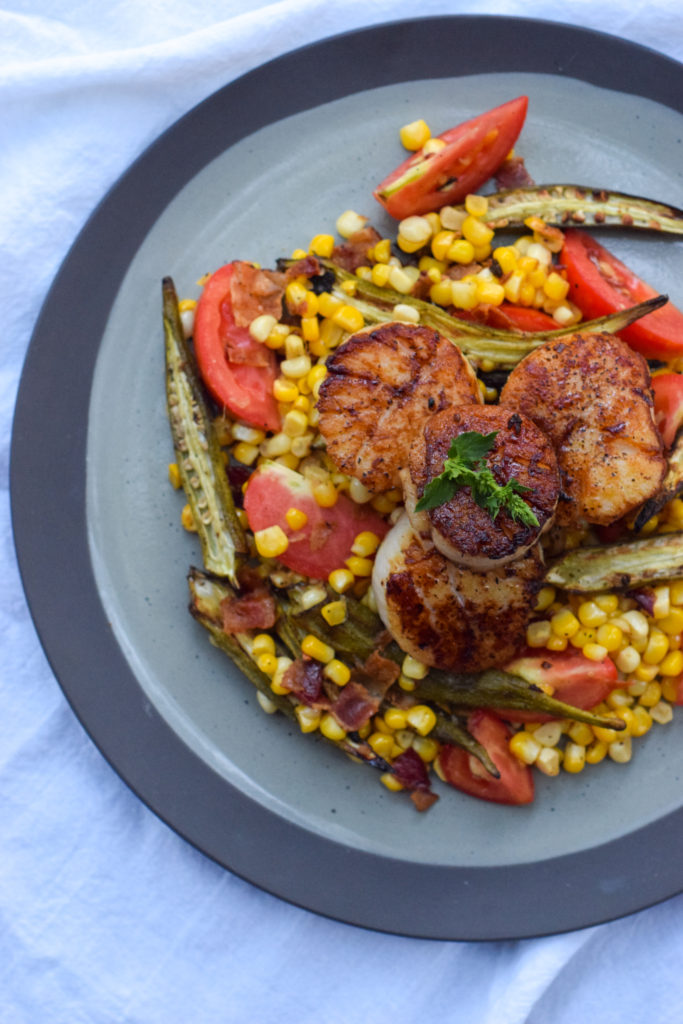 This looks absolutely mouth watering, no? Photo by the Mignoni Kitchen.
This looks absolutely mouth watering, no? Photo by the Mignoni Kitchen.
Author: The Migoni Kitchen Servings: 2 People Total Time: 50 minutes This Texas heat is no joke, so salads for dinner are sounding more and more appealing. This recipe for seared scallops with a warm corn, tomato, and okra salad is the perfect way to highlight the best produce of the summertime and make an exciting salad for dinner!
Ingredients:
- 5 slices bacon
- 8 scallops (large, about ¾ lb)
- 3 ears of fresh corn, cut from cobs (or 1.5 cups frozen corn, thawed)
- 3-4 Medium Tomatoes, sliced into wedges
- 8 ounces (1 cup) fresh okra, halved.
- 1.5 tbsp olive oil
- ¼ tsp kosher salt
- ¼ tsp black pepper
- ¼ tsp granulated sugar
- 8 ounces/1 cup okra
- ¼ cup mint
- ¼ cup olive oil
- 3 tbsp red wine vinegar
- 2 tbsp honey
- Juice of 1 lemon
- ½ clove garlic
- ¼ tsp salt
- ¼ tsp pepper
Meanwhile, preheat the oven to about 400F. Toss the halved okra with olive oil, ¼ tsp salt, and ¼ tsp pepper. Lay the okra out onto baking sheet (with wire rack if you have one). Bake for 25-30 minutes until browned.
While the okra bakes, make the dressing. Add dressing ingredients into a food processor or blender and pulse until well blended. Set aside. Next, cook the scallops and corn. Heat up the reserved bacon fat over high heat. Pat scallops dry and season with salt and sugar. Sear in hot pan for about 3 minutes on each side. Take out of the pan and allow to rest on a plate for 1-2 minutes.
Next, add in the corn into your pan and saute to cook through, about 2-3 minutes. Toss the cooked corn, fresh tomatoes, bacon, and baked okra together. Divide between 2 plates and top with seared scallops and dressing.
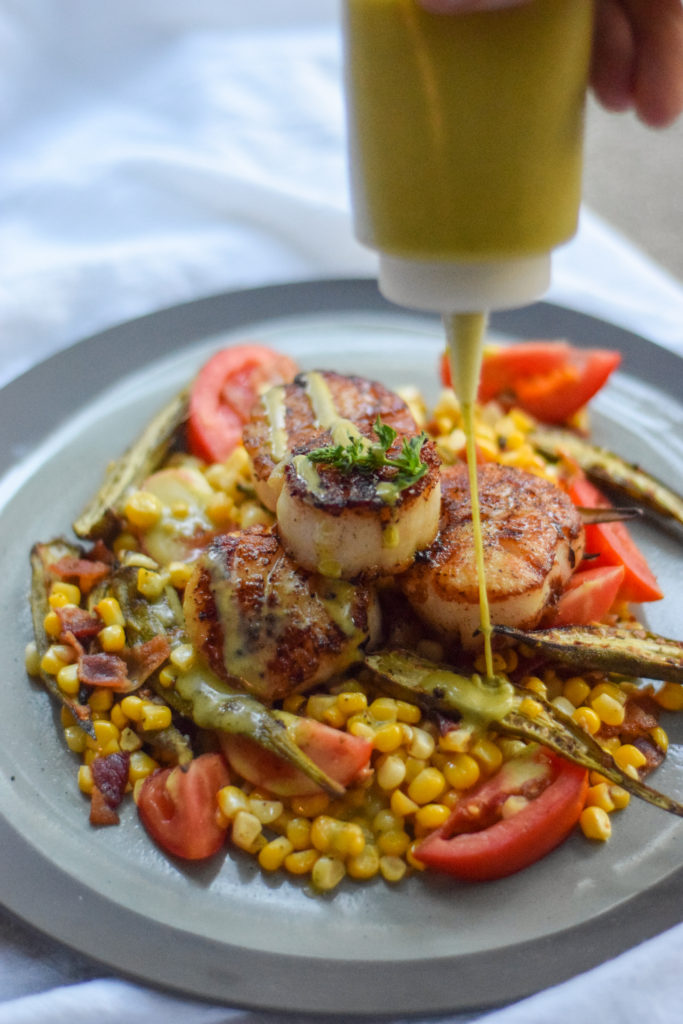 Sauce it up. Photo and food by The Migoni Kitchen
Sauce it up. Photo and food by The Migoni KitchenPHOTOS FROM THE FARM: 9.13.19
09/13/19 — Ada Broussard
There is a lot going on at a Texas vegetable farm at this time of year including prepping, planting, harvesting, and seeding. Farm photographer Scott was there to capture it all. To see more farm images, be sure to checkout our main blog post this week that looks at the intersection of art and agriculture.
![]() Krishna, our kind leader and Operations Manager, shows off a bouquet of basil to Scott (who is perched on top of a tractor). Photo by Scott David Gordon.
Krishna, our kind leader and Operations Manager, shows off a bouquet of basil to Scott (who is perched on top of a tractor). Photo by Scott David Gordon.
![]() One must arrive at the farm before sunrise to capture sunrise. Photo by Scott David Gordon.
One must arrive at the farm before sunrise to capture sunrise. Photo by Scott David Gordon.
![]() It takes all kinds. Photo by Scott David Gordon.
It takes all kinds. Photo by Scott David Gordon.
![]() Fingerling sweet potatoes - find them at markets or at your favorite restaurant, perhaps. Photo by Scott David Gordon.
Fingerling sweet potatoes - find them at markets or at your favorite restaurant, perhaps. Photo by Scott David Gordon.
![]() The art of laying drip. Photo by Scott David Gordon.
The art of laying drip. Photo by Scott David Gordon.
![]() Luis surveying his work. Photo by Scott David Gordon.
Luis surveying his work. Photo by Scott David Gordon.
![]() Giana drenching the newly seeded transplant flats under our shade structure. Photo by Scott David Gordon.
Giana drenching the newly seeded transplant flats under our shade structure. Photo by Scott David Gordon.
![]() Grow baby, grow! Photo by Scott David Gordon.
Grow baby, grow! Photo by Scott David Gordon.
![]() Okra, related to cotton, will keep flowering all summer just as long as you keep picking the okra. Stop picking, and it will stop flowering. Photo by Scott David Gordon.
Okra, related to cotton, will keep flowering all summer just as long as you keep picking the okra. Stop picking, and it will stop flowering. Photo by Scott David Gordon.
![]() Turnips looking great! Photo by Scott David Gordon.
Turnips looking great! Photo by Scott David Gordon.
![]() The bees have been loving these basil blooms. Photo by Scott David Gordon.
The bees have been loving these basil blooms. Photo by Scott David Gordon.
![]() A meeting of the minds: Brenton, Angel, and Krishna. Photo by Scott David Gordon.
A meeting of the minds: Brenton, Angel, and Krishna. Photo by Scott David Gordon.
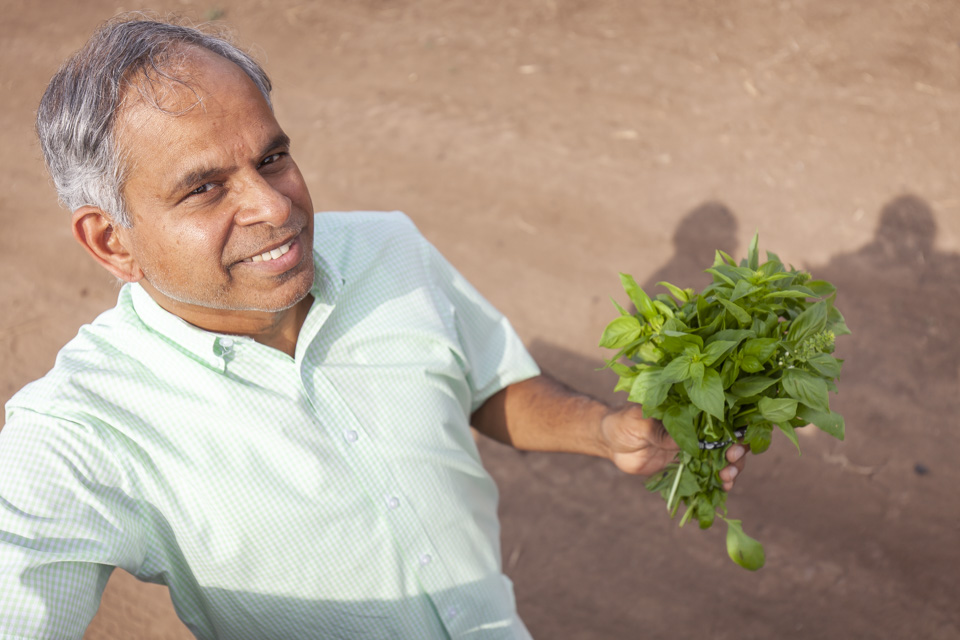 Krishna, our kind leader and Operations Manager, shows off a bouquet of basil to Scott (who is perched on top of a tractor). Photo by Scott David Gordon.
Krishna, our kind leader and Operations Manager, shows off a bouquet of basil to Scott (who is perched on top of a tractor). Photo by Scott David Gordon.
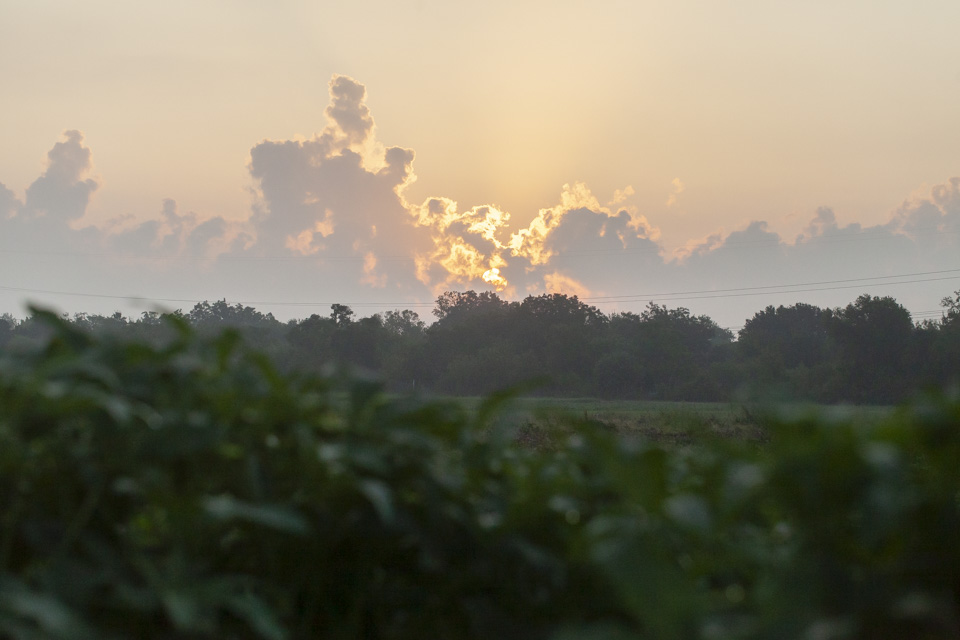 One must arrive at the farm before sunrise to capture sunrise. Photo by Scott David Gordon.
One must arrive at the farm before sunrise to capture sunrise. Photo by Scott David Gordon.
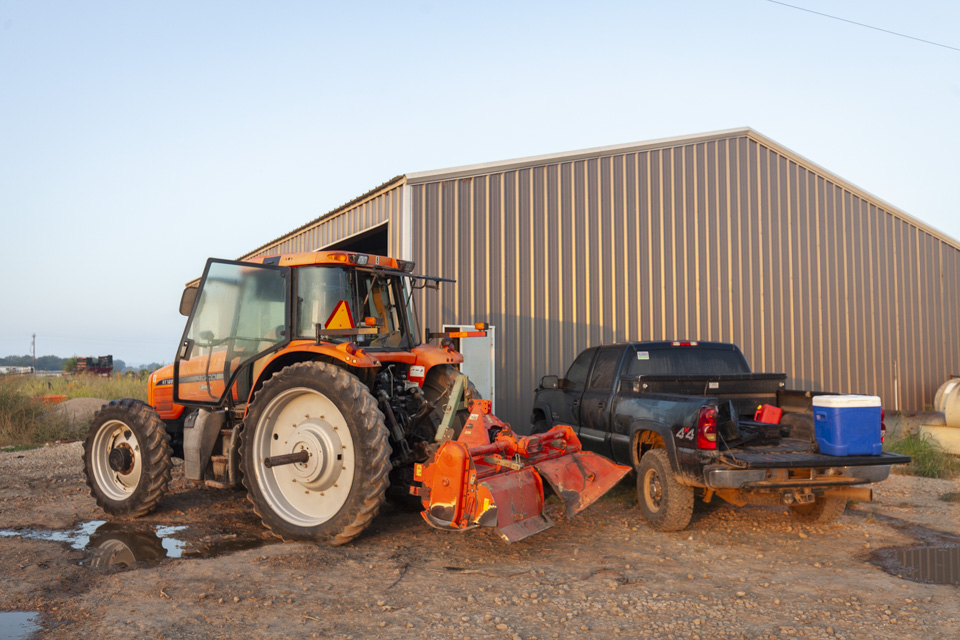 It takes all kinds. Photo by Scott David Gordon.
It takes all kinds. Photo by Scott David Gordon.
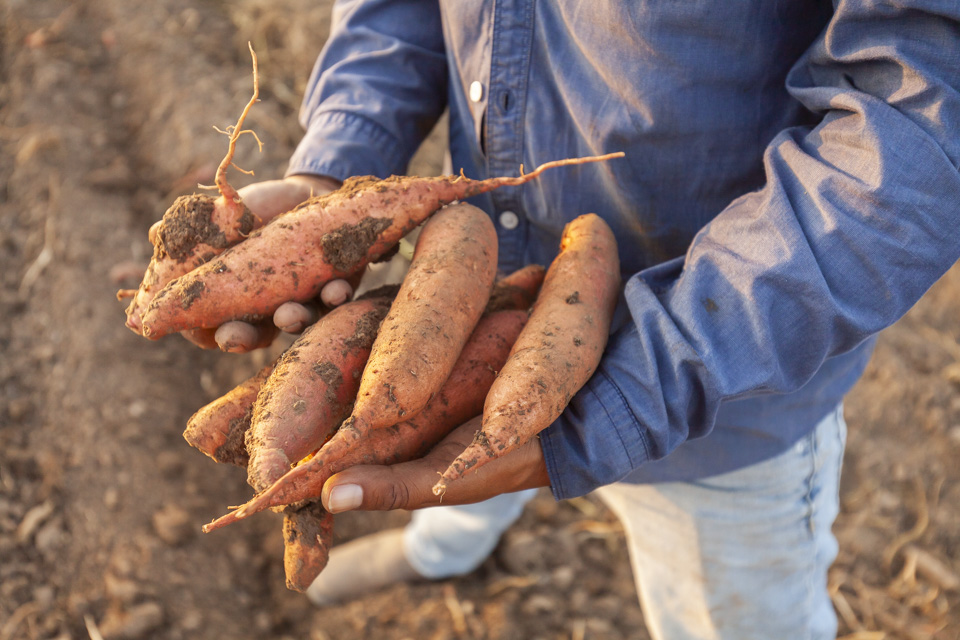 Fingerling sweet potatoes - find them at markets or at your favorite restaurant, perhaps. Photo by Scott David Gordon.
Fingerling sweet potatoes - find them at markets or at your favorite restaurant, perhaps. Photo by Scott David Gordon.
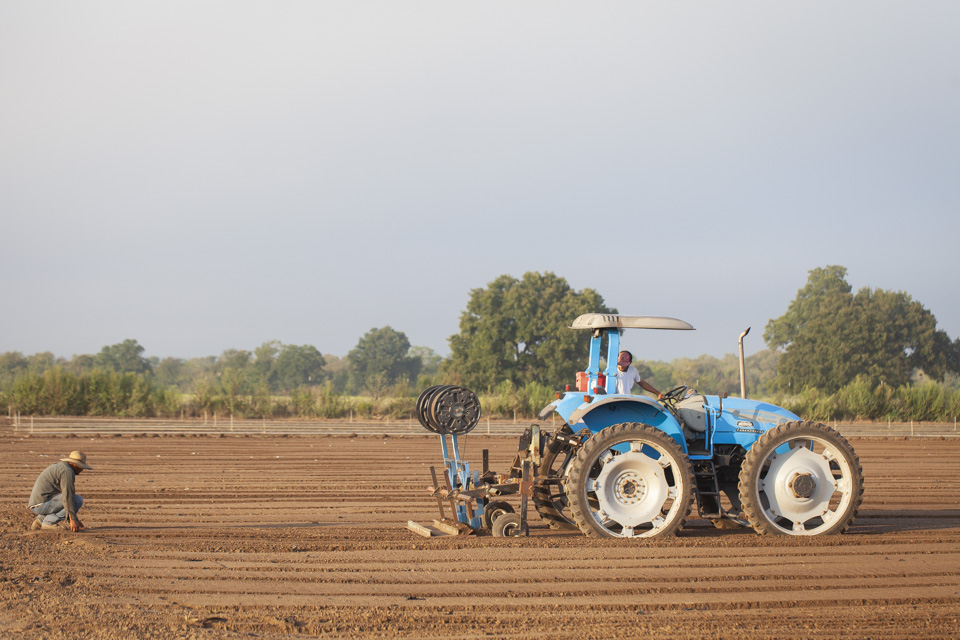 The art of laying drip. Photo by Scott David Gordon.
The art of laying drip. Photo by Scott David Gordon.
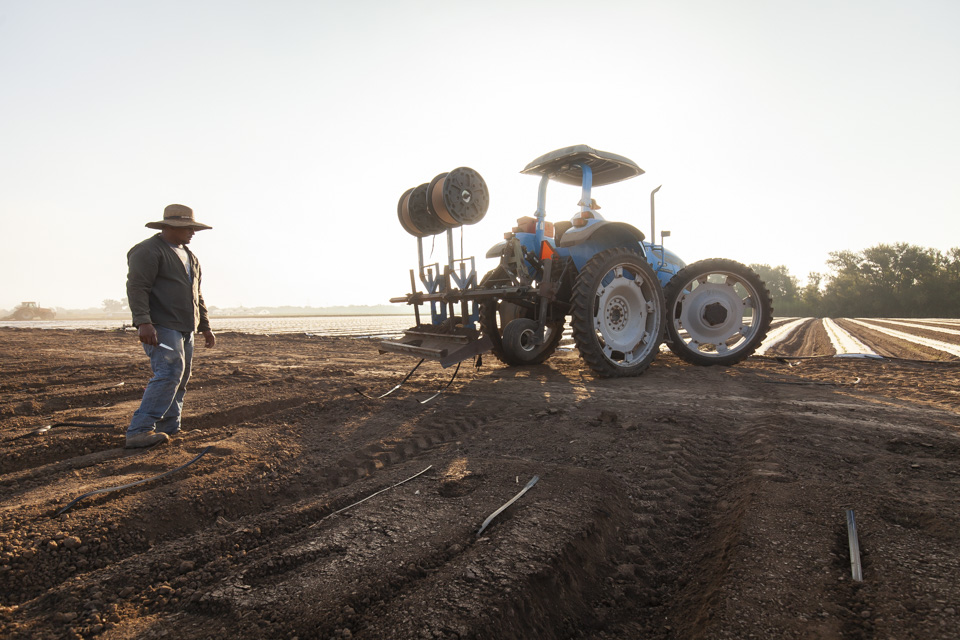 Luis surveying his work. Photo by Scott David Gordon.
Luis surveying his work. Photo by Scott David Gordon.
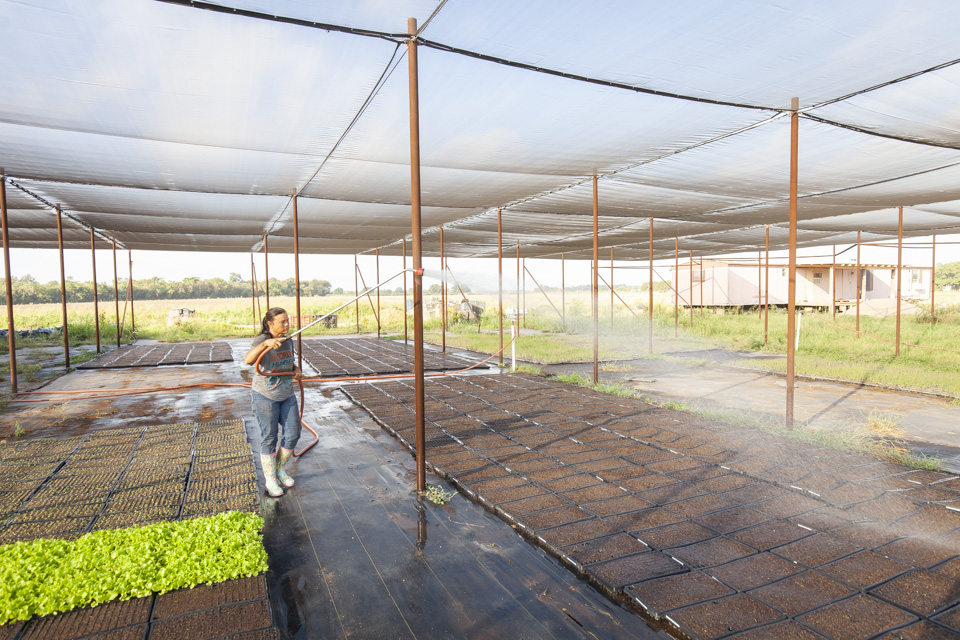 Giana drenching the newly seeded transplant flats under our shade structure. Photo by Scott David Gordon.
Giana drenching the newly seeded transplant flats under our shade structure. Photo by Scott David Gordon.
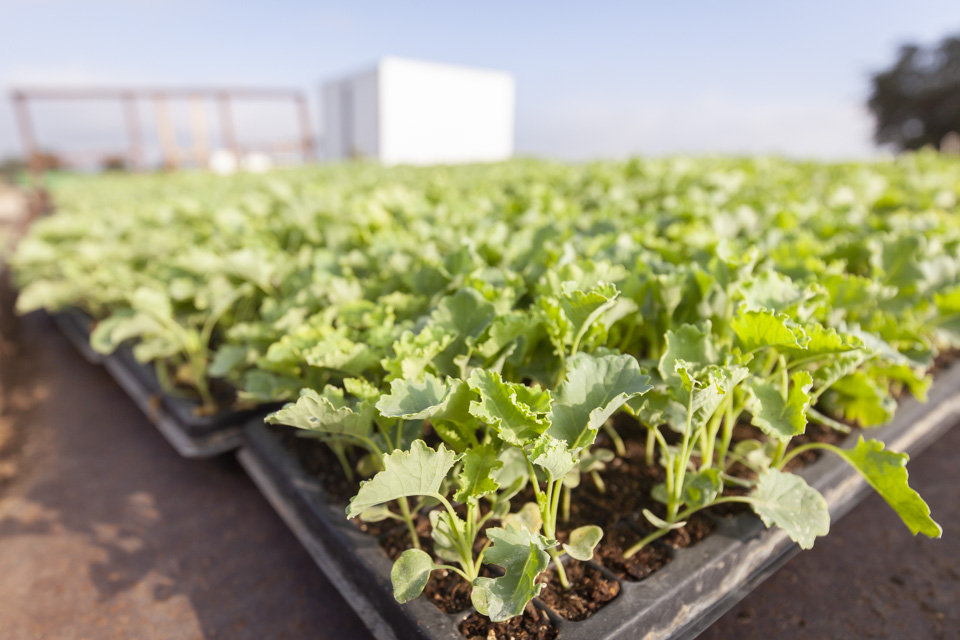 Grow baby, grow! Photo by Scott David Gordon.
Grow baby, grow! Photo by Scott David Gordon.
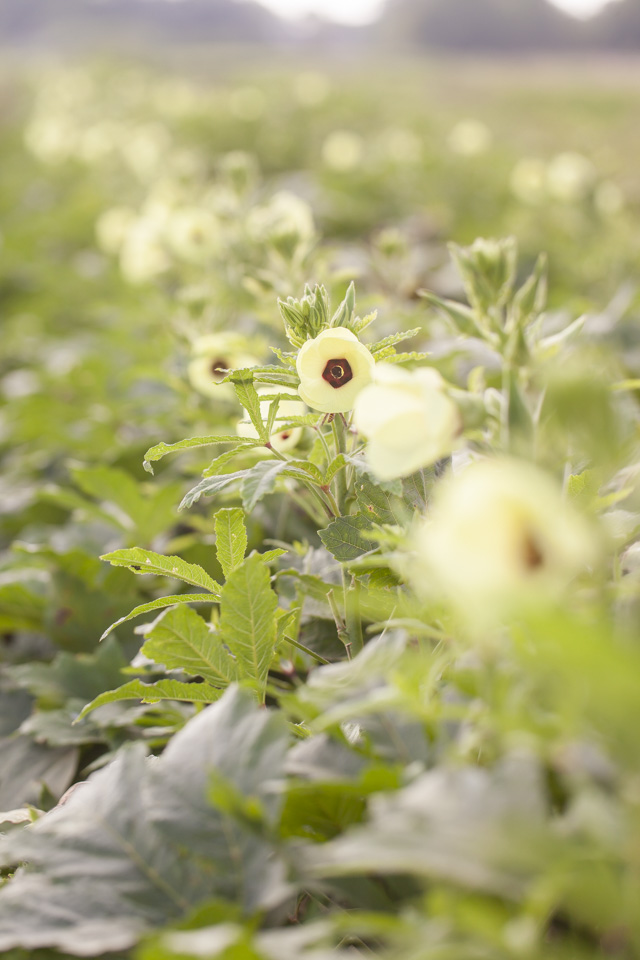 Okra, related to cotton, will keep flowering all summer just as long as you keep picking the okra. Stop picking, and it will stop flowering. Photo by Scott David Gordon.
Okra, related to cotton, will keep flowering all summer just as long as you keep picking the okra. Stop picking, and it will stop flowering. Photo by Scott David Gordon.
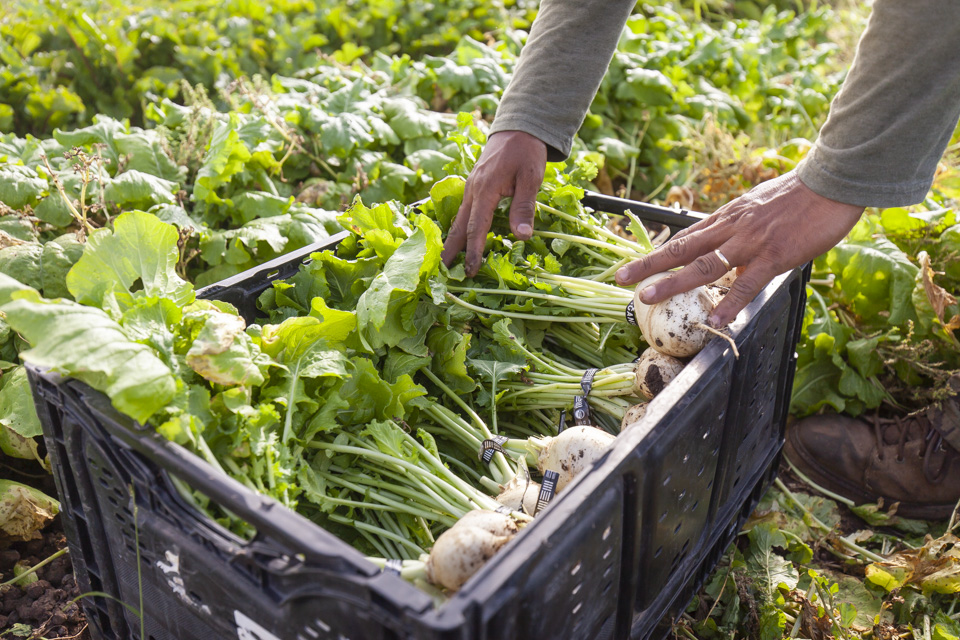 Turnips looking great! Photo by Scott David Gordon.
Turnips looking great! Photo by Scott David Gordon.
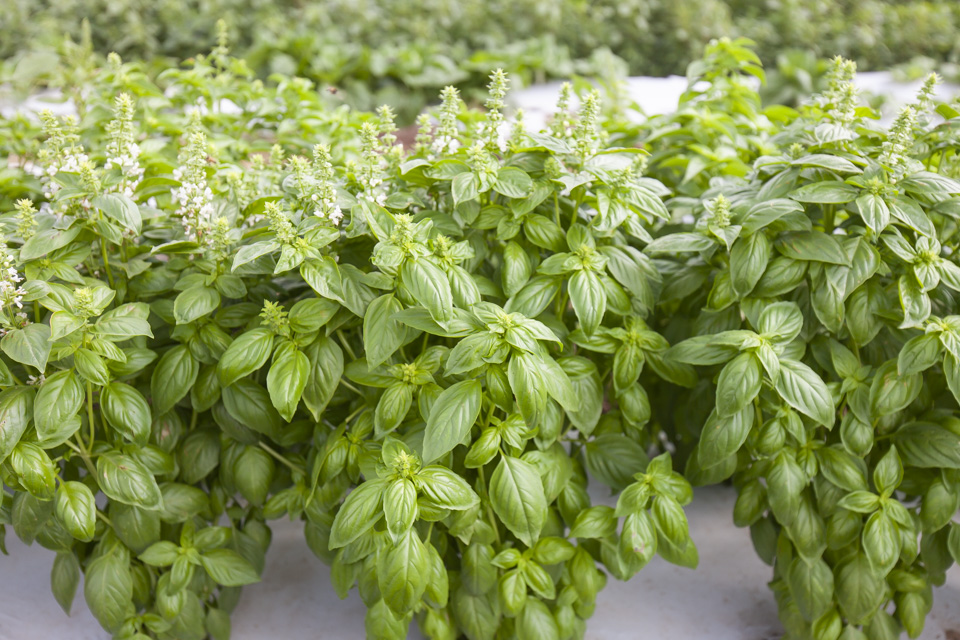 The bees have been loving these basil blooms. Photo by Scott David Gordon.
The bees have been loving these basil blooms. Photo by Scott David Gordon.
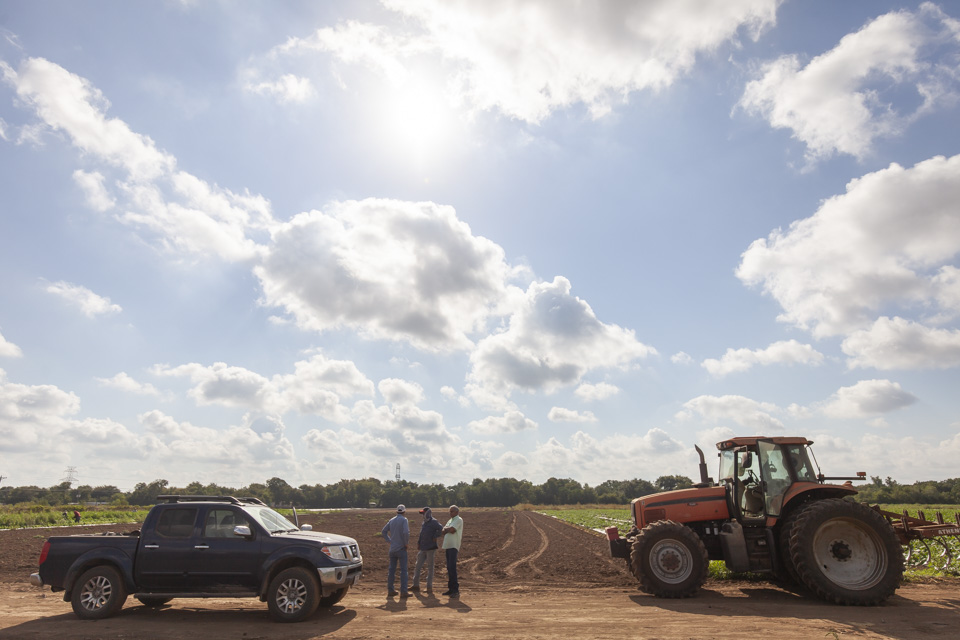 A meeting of the minds: Brenton, Angel, and Krishna. Photo by Scott David Gordon.
A meeting of the minds: Brenton, Angel, and Krishna. Photo by Scott David Gordon.SOME NATURAL INSPIRATION
09/13/19 — Ada Broussard
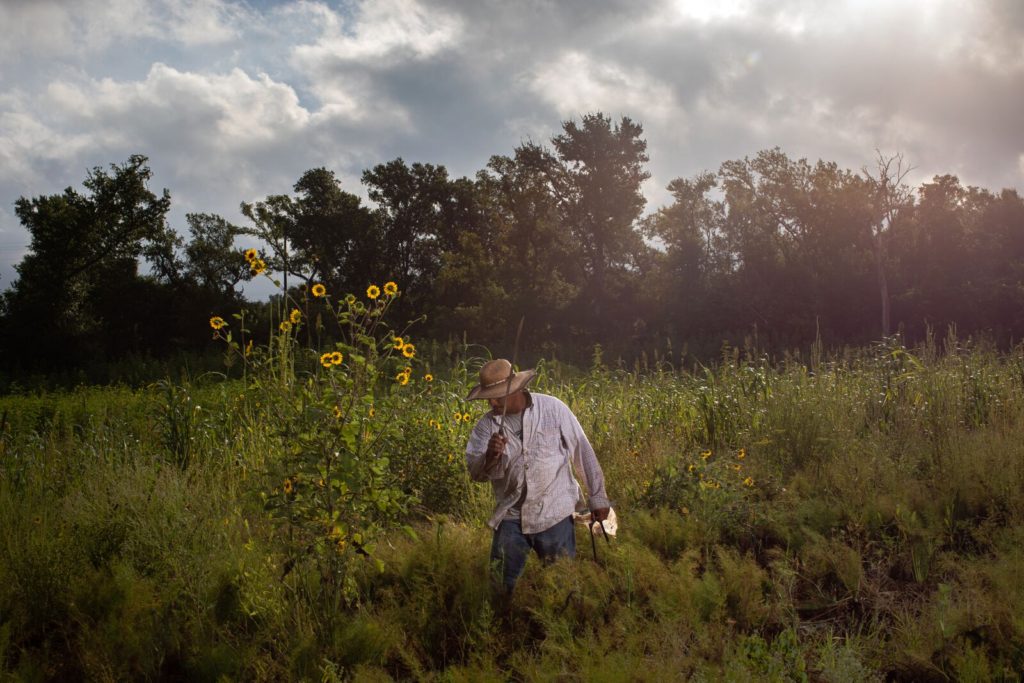 Photo taken this summer at the farm by Tamir Kalifa. Here Luis is using a machete in a jungle of weeds to clear a path.
Photo taken this summer at the farm by Tamir Kalifa. Here Luis is using a machete in a jungle of weeds to clear a path.
Today's post is an inspired one. Today, we are dipping the very tip of our steel toe in the vast world of art and nature/art and agriculture, and are sharing a few of works of our favorite artists that use the earth as their creative medium and farm fare as their subject matter.
Is there anything more awe-inspiring than the blows and bounty of mother nature herself? It’s no surprise that the intersection of farmers and artists is a natural one. Both pursuits require an attitude and a spirit of fearlessness. Both strive to create something greater than themselves, beginning with only a few humble materials. Both farmers and artists have forgone practical reason and chosen a path that seldom is financially secure (or easy). While farmers might not ever be troubled with the “starving” modifier, both farmers' and artists' success is driven by market factors outside their control. But somehow, farmers grow and artists create, both driven by forces as strong as these days are long. Farmers, who are both chemical and biological wizards, combining seeds as wispy as the hairs on your arm with soil, water, and minerals to create vibrant, edible(!), and nourishing(!) plants, are artists in their own right. Or so we (farmers) like to think.
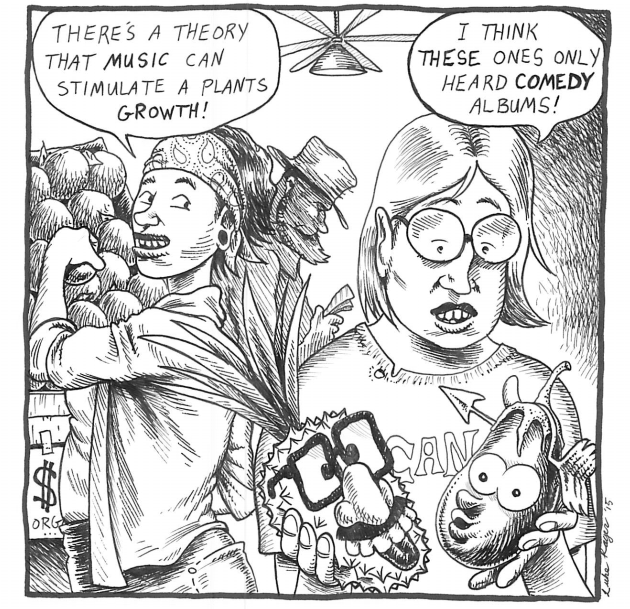 Original farmtoon illustration by CSA Driver Lucas Rager. This one is for sale! Email ada@jbgorganic.com for info.
Original farmtoon illustration by CSA Driver Lucas Rager. This one is for sale! Email ada@jbgorganic.com for info.
On an introspective day, the germination of small black watermelon seed into a tiny but sturdy green sprout, and then into seven pounds of sweet and vibrant pink flesh is spellbinding. But on most days, this germination and the harvesting of this heavy crop is the day’s tasks. We are so interconnected with the natural world that its functions aren't there to be analyzed, and instead are there to be lived. But does an artist always know when they’re creating a masterpiece? Perhaps we’re indulging too much here, but we do think our carrots are quite phenomenal.
Maybe it’s the cooler season ahead and the faint (but detectable) rumors that a reprieve is on its way that have us so inspired. Maybe it’s the way the breeze feels right before the sun comes up. Maybe it’s the way the dirt smells when the drip irrigation has been turned on, the soil saturated, the plants singing. Well, whatever it is, we’re quite inspired by the natural beauty of our natural landscape right now, and are thrilled that there artists out there are able to capture this agrarian experience .
NATURAL LANDSCAPES, NATURAL MATERIALS AS ART
The following artist, in one way or another, use elements in the natural world to create their work.Agnes Denes
 Photo of Agnes Denes, by Agnes Denes. Courtesy of her website.
Photo of Agnes Denes, by Agnes Denes. Courtesy of her website.
 © Agnes Denes. Courtesy Leslie Tonkonow Artworks + Projects, New York
© Agnes Denes. Courtesy Leslie Tonkonow Artworks + Projects, New York
Agnes Denes’s piece “Wheatfield - A confrontation: Battery Park Landfill” was at the forefront of our minds when considering the intersection of agriculture and art. In May of 1982, this land artist planted 2 acres of golden wheat on a landfill in Manhattan, only a few blocks away from the Statue of Liberty and the World Trade Center. To complete the task, two hundred truckloads of topsoil were brought in, and hundreds of pounds of garbage and rock were removed to ready the land. After being carefully farmed by this artist, 1,000 pounds of wheat were harvested.
Denes on the piece: “ Planting and harvesting a field of wheat on land worth $4.5 billion created a powerful paradox. Wheatfield was a symbol, a universal concept; it represented food, energy, commerce, world trade, and economics. It referred to mismanagement, waste, world hunger and ecological concerns. It called attention to our misplaced priorities. The harvested grain traveled to twenty-eight cities around the world in an exhibition called "The International Art Show for the End of World Hunger", organized by the Minnesota Museum of Art (1987-90). The seeds were carried away by people who planted them in many parts of the globe.” (Quote taken from Agnes Dene’s website, which you should visit to see more incredible pictures of this piece, along with others.)
Andy Goldsworthy:
 Sculpture and photo by Andy Goldsworthy as a part of his Ephemeral Works series.
Sculpture and photo by Andy Goldsworthy as a part of his Ephemeral Works series.
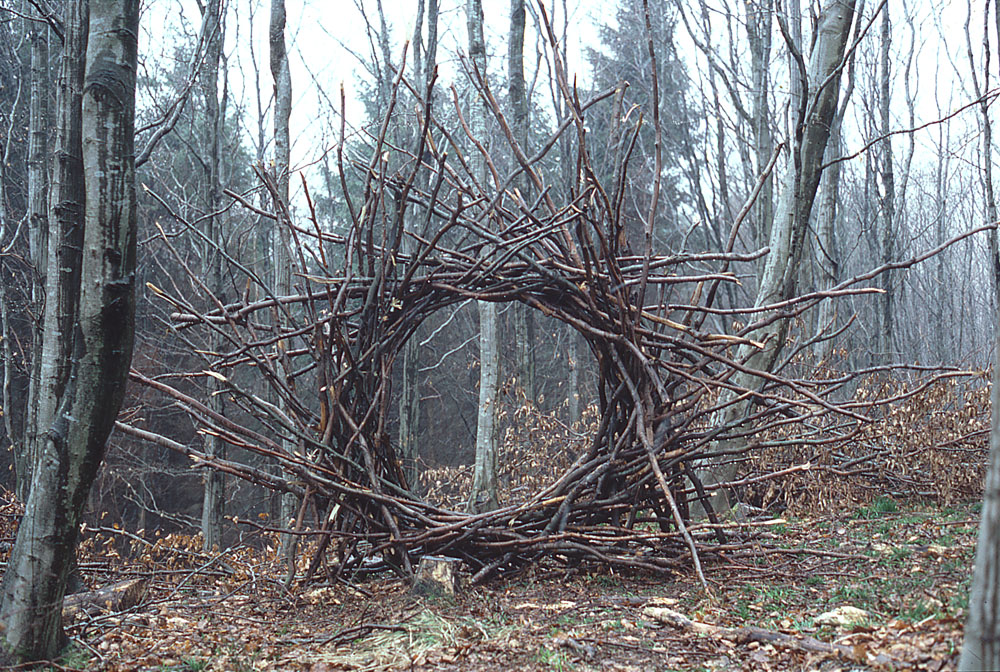 Sculpture and photo by Andy Goldsworthy as a part of his Ephemeral Works series.
Sculpture and photo by Andy Goldsworthy as a part of his Ephemeral Works series.
Andy Goldsworthy is a British sculptor known best for use of leaves, sticks, stones, and even snow and ice to create temporary art pieces, all subject to the degradation from natural forces, whether it be over the course of years or in a matter of moments. From around the age of 13, Goldworthy worked on farms in Yorkshire, England. When asked about his tediously constructed sculptures, Goldworthy says the time consuming yet meditative aspects of farm work primed him for his sculpture work. In 2007 he told the Guardian, "A lot of my work is like picking potatoes. You have to get into the rhythm of it. Farming is a very sculptural profession. Building haystacks or ploughing fields, burning stubble." You're welcome to come pick our potatoes anytime, Andy. We know the rhythm you speak of!
James Turrell:
 James Turrell Third Breath (2009) , Photo: via Kunstgebiet
James Turrell Third Breath (2009) , Photo: via Kunstgebiet
We’re so lucky to have one of the works of land artist, James Turrell, up for public enjoyment at the University of Texas. Instead of creating a piece from tangible naturals like twigs and mud, Turrell simply creates a space where light, itself, is art. Viewing his “Skyscape” is a truly incredible experience, accessible to all of us Austinites via a quick field trip to UT. We strongly encourage you to visit this exhibit. For a sunset viewing, you must make reservations ahead of time. Prepare to be peaceful.
Mark Dion:
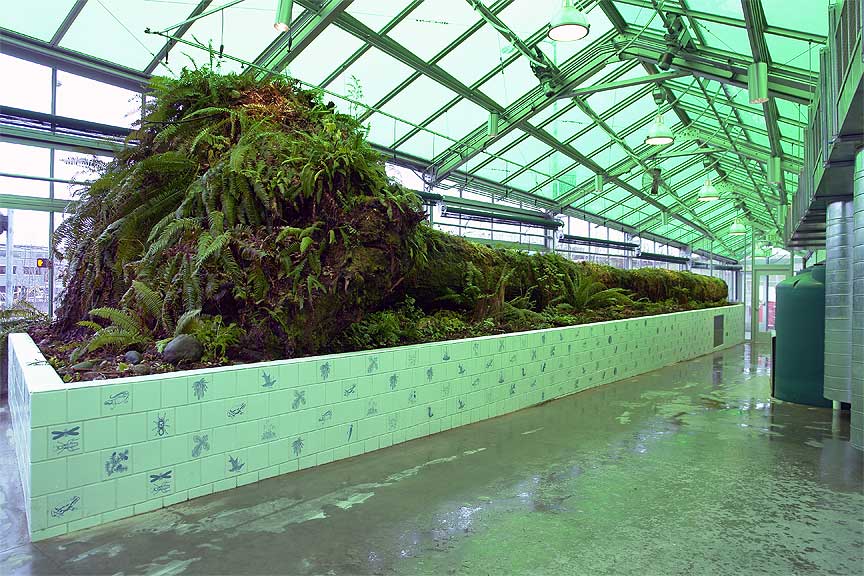 Neukom Vivarium, 2006. Mixed-media installation, greenhouse structure: 80 feet long. Installation view: Olympic Sculpture Park, Seattle. Courtesy of the Seattle Art Museum.
Neukom Vivarium, 2006. Mixed-media installation, greenhouse structure: 80 feet long. Installation view: Olympic Sculpture Park, Seattle. Courtesy of the Seattle Art Museum.
 Production still from the Art in the Twenty-First Century Season 4 episode, Ecology. Segment: Mark Dion. © Art21, Inc. 2007.
Production still from the Art in the Twenty-First Century Season 4 episode, Ecology. Segment: Mark Dion. © Art21, Inc. 2007.
Mark Dion, an American conceptual artist working out of New York and Pennsylvania, is known for his exhibition of the national world in a scientific context. In his work “Neukon Vivarium” he took a massive fallen hemlock tree, and put its degradation on display in a carefully constructed greenhouse. Dion, on this piece: “ I think that one of the important things about this work is that it’s really not an intensely positive, back-to-nature kind of experience. In some ways, this project is an abomination. We’re taking a tree that is an ecosystem—a dead tree, but a living system—and we are re-contextualizing it and taking it to another site. We’re putting it in a sort of Sleeping Beauty coffin, a greenhouse we’re building around it. And we’re pumping it up with a life support system—an incredibly complex system of air, humidity, water, and soil enhancement—to keep it going. “ (Quote courtesy of this interview via Art 21)
Maura Ambrose:
Mara Ambrose is an example of the artists and makers out there who transform raw materials from the natural world to create something beautiful, colorful, and in this case, cozy. Maura uses native plants to create natural dyes and uses those to create fiber art that you can use - beautiful heirloom quilts. See her creations on the Folk Fibers website.
 "Flying Geese", courtesy of Folks Fiber's website. Fun fact: Mara used to be the JBG Greenhouse Manager 10 or so years ago.
"Flying Geese", courtesy of Folks Fiber's website. Fun fact: Mara used to be the JBG Greenhouse Manager 10 or so years ago.
FARMS AND FARM PRODUCTS AS ART
Pastoral landscapes have been inspiring artists for centuries, and ever since the Impressionist marched outdoors to capture these scenes, farms have been the subject of art. Here, we’ve decided to highlight 4 local Austin artists who use photography and watercolor to capture the spirit of farm life and the beauty of its products.Scott David Gordon
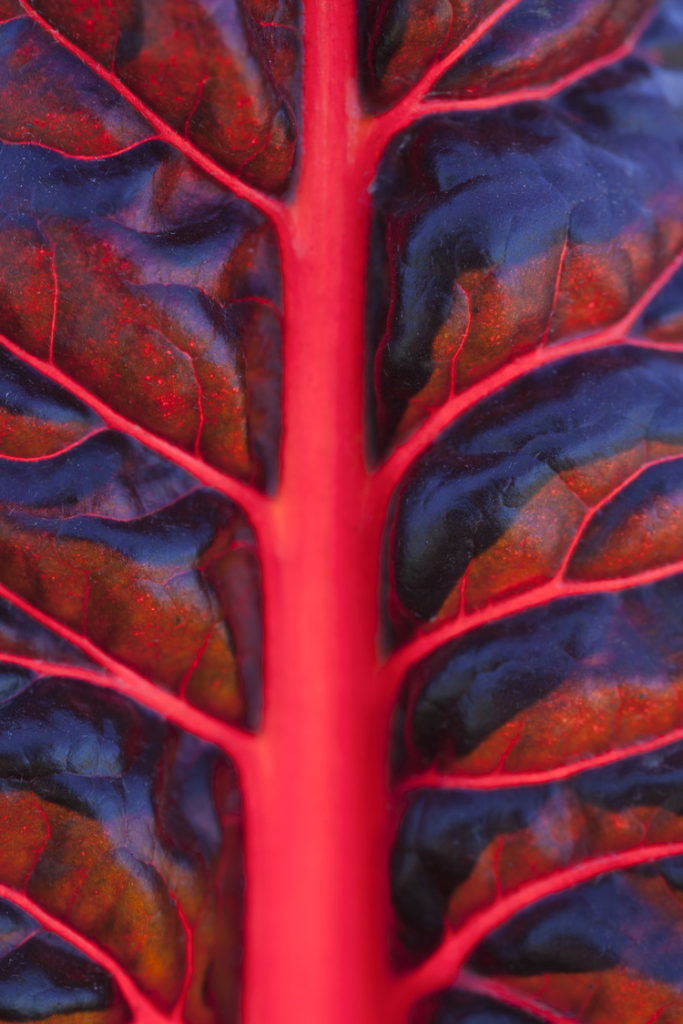 If you look hard, it's chard. Photo by Scott.
If you look hard, it's chard. Photo by Scott.
If you read our blog regularly, Scott David Gordon should be a household name. Scott began at JBG as a delivery driver, but soon began to capture JBG’s farmscapes via digital photography. He has photographed the farm, just about every week, for almost 10 years! (Here are this week’s photos.) We highlight his photographs in our weekly blog, and when considered longitudinally, his photos tell our story better than we ever could.
Scott is there to capture something as stunning as the morning dew puddled on wrinkly nappa cabbage leaves to things more utilitarian in nature like tractor parts, welding helmets, and stacks of produce boxes. Though the physical location of Scott’s photographs remain constant, he somehow manages to capture the reality of the JBG farm world: the ever present variation of people, crops, weather, and tools. And he often has to stand on top of a tractor to do it.
 A once-was leaf. Photo by Scott David Gordon.
A once-was leaf. Photo by Scott David Gordon.
Tamir Kalifa
Tamir Kalifa is a visual journalist living in Austin, Texas. He has followed Beto O’rourke around on campaign rallies and documented the Cajun Navy’s cleanup efforts after Hurricane Harvey. Last summer Tamir shot a beautiful series of portraits of some of the JBG farm crew using his medium format Hasselblad 500 cm. He also captured a series of aerial photographs which make our tractor passes look like carefully orchestrated crop circles. Which maybe, they were.
This summer, Tamir visited the farm again and paired an off-camera flash with his digital camera to add a surreal, vivid element to everyday scenes on the farm. Below, our everyday farm truck, takes on a magical and cinematic quality, and we can’t quite tell if we’re about to be transported into a virtual reality farming game of the future or into a Baroque painting of the past.
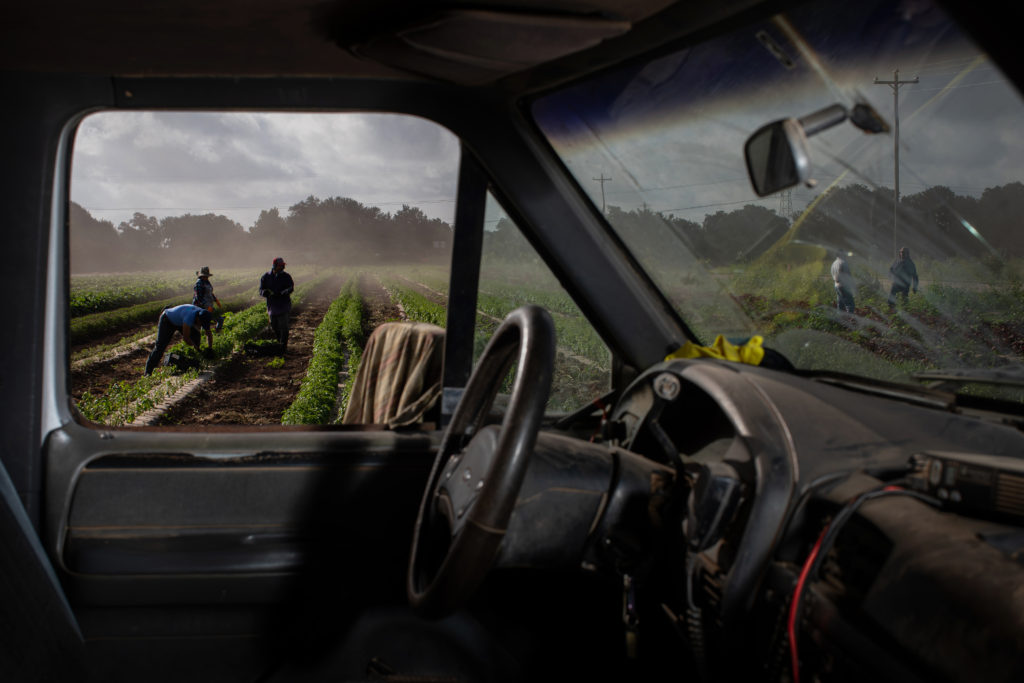 A view into our world. Photo by Tamir Kalifa.
A view into our world. Photo by Tamir Kalifa.
 Basil twist-tying, from below. Photo by Tamir Kalifa.
Basil twist-tying, from below. Photo by Tamir Kalifa.
Mackenize Smith
We first met Mackenzie by way of her beautiful food photography, and somehow convinced her to contribute to our blog as a recipe developer. Her eye for color and light define just about every one of her photos, and her fantastic food styling makes you want to take a bite of whatever it is she’s whipped up. We love the way she made this okra swim for a study she did of our summer produce back in 2018.
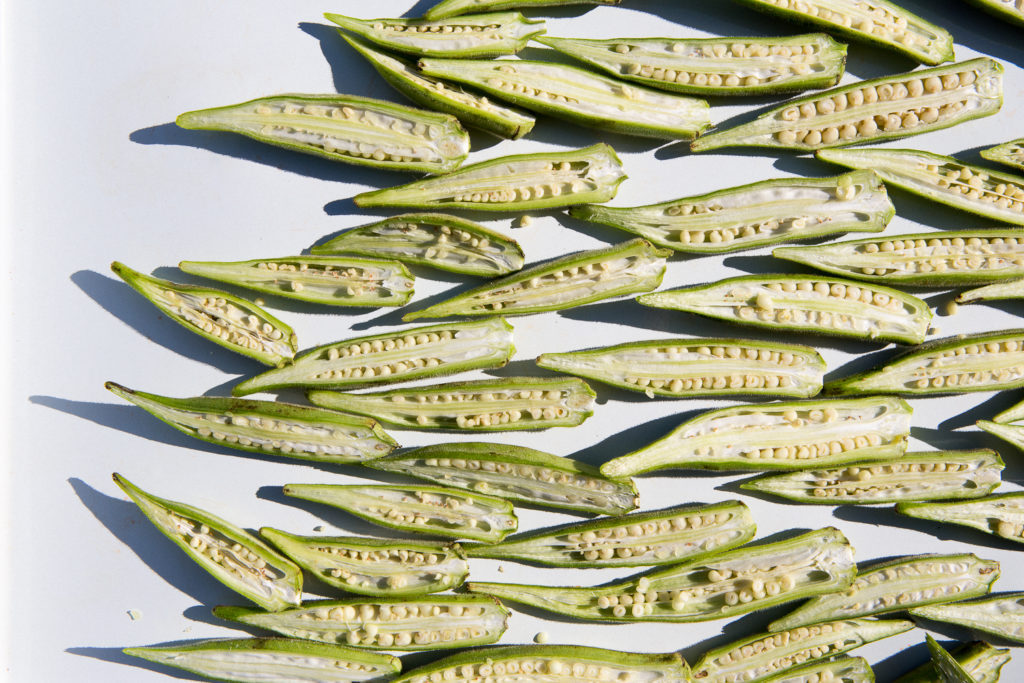 Okra migration. Photo by Mackenzie.
Okra migration. Photo by Mackenzie.
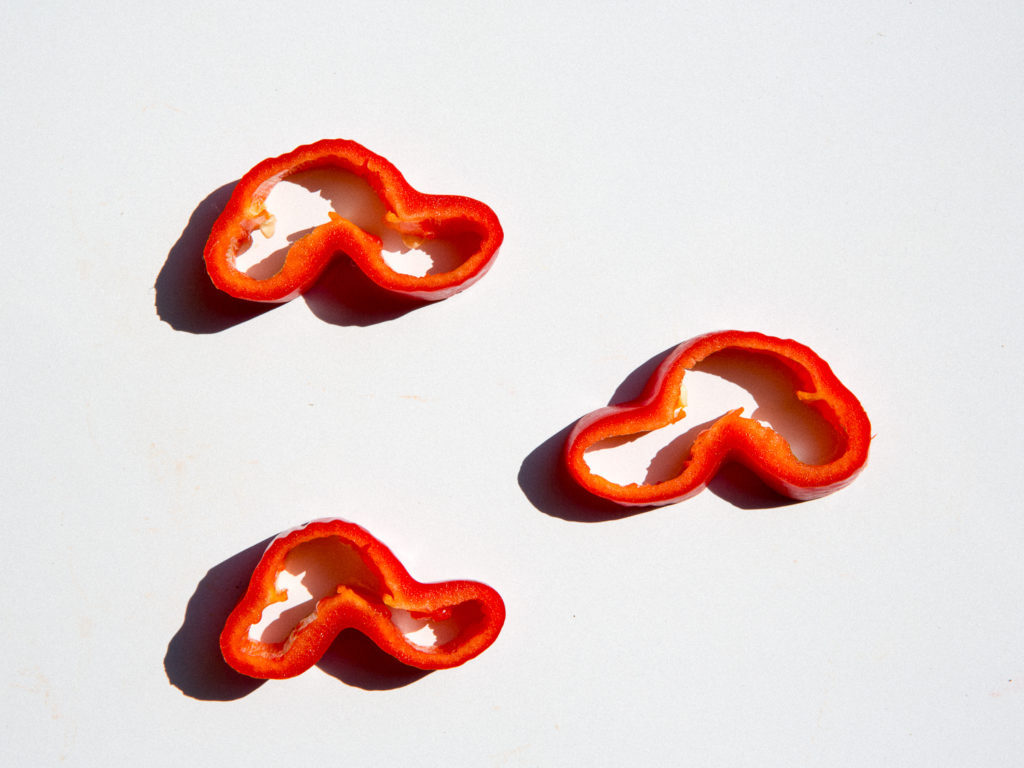 Peppers. Photo by Mackenzie.
Peppers. Photo by Mackenzie.
Jan Heaton
Local watercolor painter, Jan Heaton, highlights the beauty of local produce in her series “The Market” in which shapes, lines, and colors at one moment feel like an abstract illusion, and at another moment feel like an onion. Or, a watermelon radish. If you’d like to hear Jan talk about her process, we encourage you to checkout Scott’s recent podcast on the subject. Here is a link.
 Watermelon radish. Photo courtesy of Jan's website.
Watermelon radish. Photo courtesy of Jan's website.
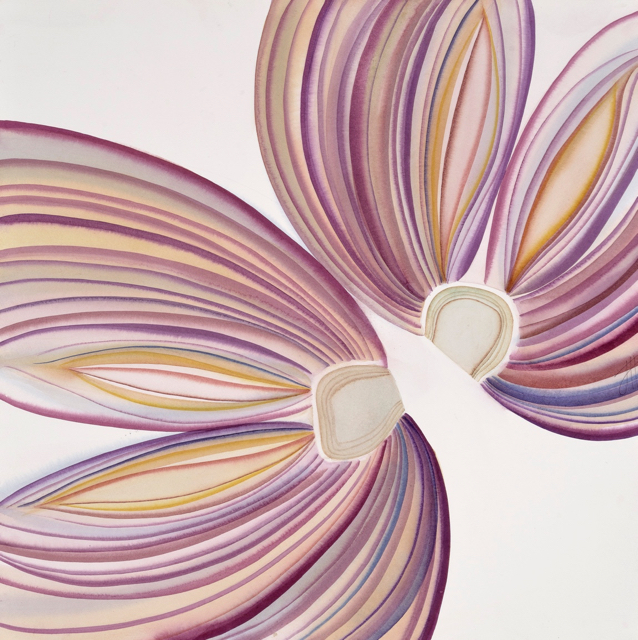 Photo courtesy of Jan's website. High resolution tiff photo on DVD- Holland Photo
Photo courtesy of Jan's website. High resolution tiff photo on DVD- Holland Photo
Farmers as Artists
“We have neglected the truth that a good farmer is a craftsman of the highest order, a kind of artist.” - Wendell Berry.We opened this week’s blog post positing that farmers, themselves, are artists. The way farmers manipulate the earth, and perhaps even the way they season and cook their harvests, is a craft. Many farmers use medium beyond the barnyard, and are talented visual artists, too. Prizer Gallery in East Austin is currently showing an exhibit featuring the visual art of local area farmers, and includes work from JBG staff as well as other local farms like Boggy Creek, Millberg Farm, Middle Grown Farm, Farmshare, and Munkebo… just to name a few. Whether you make a trip to see the Turrell exhibit, make an appointment to see the Farmer as Artist show, or perhaps play with your food and make some edible art, we hope you find some inspiration this weekend.
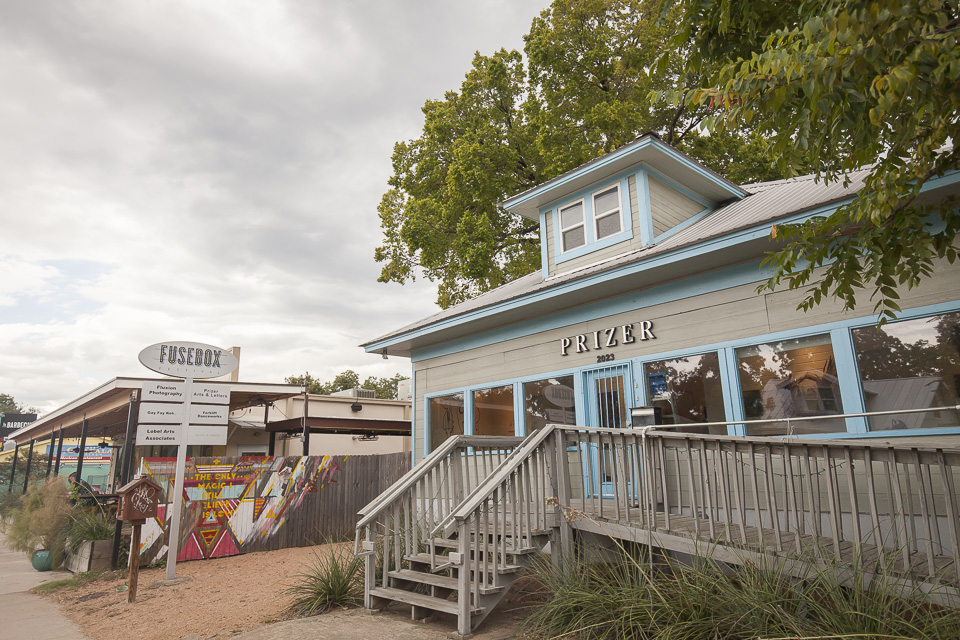 Checkout the Farmer as Artist exhibit that is up at Prizer Gallery. Contact them via Facebook for viewing times. Photo by Scott.
Checkout the Farmer as Artist exhibit that is up at Prizer Gallery. Contact them via Facebook for viewing times. Photo by Scott.
CSA BOX CONTENTS WEEK OF SEPT 16TH
09/17/19 — Scott
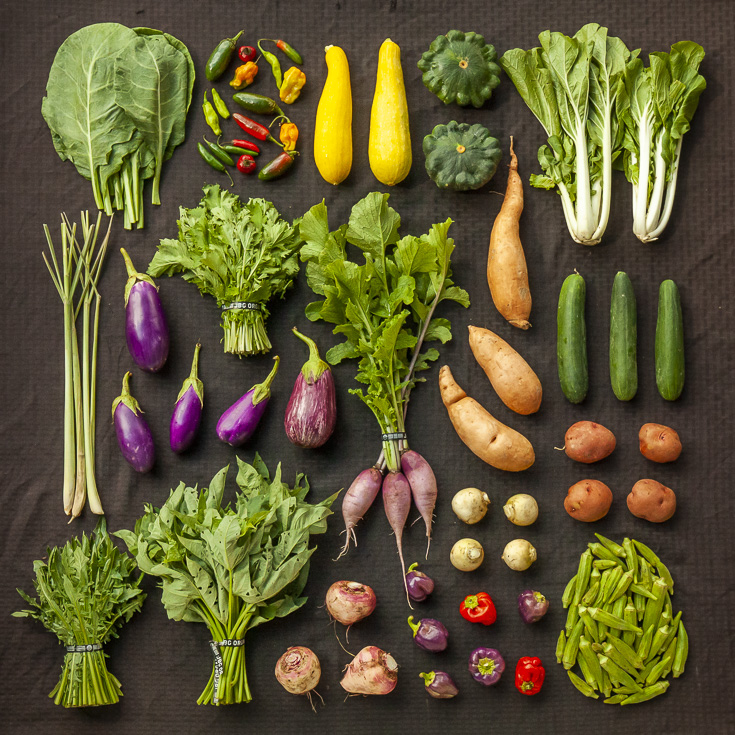 CSA Box Contents Week of Sept 16th
CSA Box Contents Week of Sept 16th
Large Box
Eggplant
Greens, Arugula
Greens, Collards
Greens, Mizuna
Herb, Farmers Choice
Melon, Farmers Choice
Okra
Pepper, Sweet
Potato
Radish
Squash, Farmer's Choice
Turnips
Eggplant
Greens, Arugula
Greens, Collards
Greens, Mizuna
Herb, Farmers Choice
Melon, Farmers Choice
Okra
Pepper, Sweet
Potato
Radish
Squash, Farmer's Choice
Turnips
Medium Box
Cucumber
Greens, Arugula
Greens, Mizuna
Herb, Farmers Choice
Melon, Farmers Choice
Okra
Potato
Radish
Squash, Farmer's Choice
Turnips
Cucumber
Greens, Arugula
Greens, Mizuna
Herb, Farmers Choice
Melon, Farmers Choice
Okra
Potato
Radish
Squash, Farmer's Choice
Turnips
Small Box
Bok Choy, Baby
Cucumber
Eggplant
Greens, Collards
Herb, Farmers Choice
Potato
Turnips
Bok Choy, Baby
Cucumber
Eggplant
Greens, Collards
Herb, Farmers Choice
Potato
Turnips
Individual Box
Eggplant
Greens, Collards
Potato
Squash, Farmer's Choice
Turnips
Eggplant
Greens, Collards
Potato
Squash, Farmer's Choice
Turnips
CSA BOX CONTENTS WEEK OF SEPT 16TH
09/17/19 — Scott
 CSA Box Contents Week of Sept 16th
CSA Box Contents Week of Sept 16th
Large Box
Bok Choy
Cucumber
Greens, Collards
Greens, Mustard
Herb, Farmers Choice
Okra
Pepper, Hot Medley
Pepper, Sweet
Potato
Radish
Squash, Farmer's Choice
Turnips
CARROT HUMMUS
09/18/19 — Ada Broussard
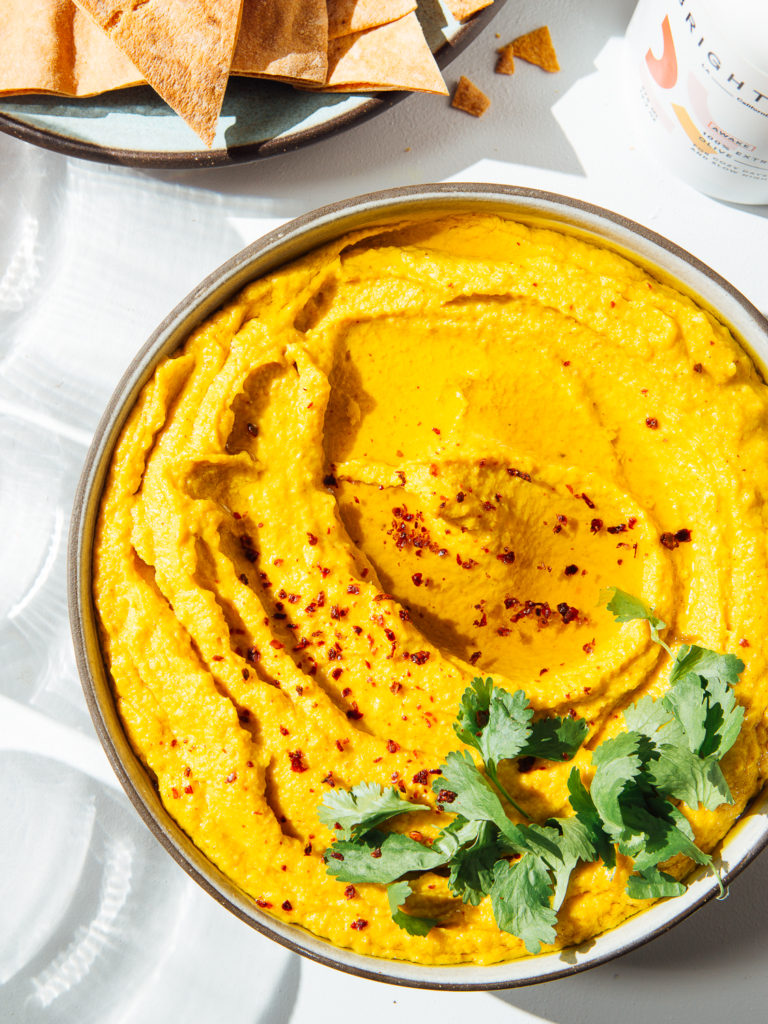 A local and seasonal version of everyone's favorite snack. Photo by Mackenzie Smith
A local and seasonal version of everyone's favorite snack. Photo by Mackenzie Smith
Last year, Ada Broussard, the co-founder of Club Homemade, served a carrot hummus during our book club that spurred a year of me trying to copy her perfect dip. By now, I have made so many iterations that I’m not sure if its anything like Ada's original, but it is just as tasty. There are plenty of ways to make this your own based on what you have available: swap beets for carrots, tahini or nut butter for peanut butter, lime for lemon, etc. This recipe is a delicious way to use up a solid pound of carrots, and the perfect answer to daily snacking needs.
Ingredients:
- 1 bunch of carrots, washed and dried
- 5 tablespoons olive oil
- salt
- pepper
- 1 1/2 teaspoon turmeric
- 1 teaspoon salt
- 2 teaspoons black pepper
- turmeric
- 2 tablespoons miso
- zest of half a lemon
- juice of one lemon
- 4 tablespoons peanut butter
- 2 cloves garlic
- 1 can of chickpeas, drained
- olive oil
- salt to taste
Instructions:
Preheat oven to 450
Place carrots in a half sheet pan, drizzle with olive oil-- enough to coat the carrots and then some, erring on the side of "more is more"
Sprinkle salt and pepper
Roast for 10 minutes, then turn each carrot so the other side can brown on the hot pan.
Roast for another 10-15 minutes, until carrots are caramelized and very fork-tender.
While carrots are in the oven, add the turmeric, miso, peanut butter, lemon juice and zest, garlic, black pepper, and a teaspoon of salt to the food processor. Blend until completely smooth. Add the chickpeas and blend until smooth (1-2 minutes). Once carrots have cooled, chop into 1-inch pieces and blend in the food processor until smooth, another 1-2 minutes. Add water or olive oil, 1 tablespoon at a time if needed to achieve desired texture. Taste, and add salt if needed.
Transfer hummus to a bowl and drizzle with olive oil, fresh herbs and chili flakes. Serve with fresh pita, chips, or crudite.
EATING FOR PLANETARY HEALTH
09/19/19 — Ada Broussard
This week we're sharing a piece written by our friends at the Sustainable Food Center about how to eat to better for the health of the planet. There are so many reasons that many of you choose to be CSA Members including the convenience of delivery, the quality and taste of the produce, the interest in supporting the local economy... but today we're here to remind you that no matter what reason you choose to buy produce from us, you're also doing Plant Earth a favor. As always, thank you for your support! And thank you to SFC for sharing this wonderful piece!
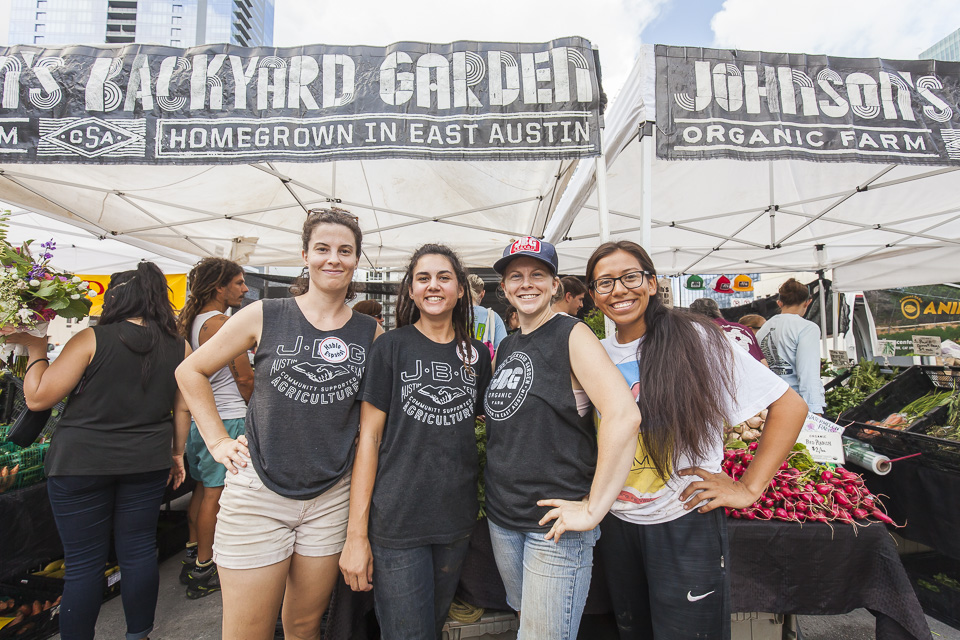 Friendly farmer faces are another good reason to buy locally. Photo by Scott David Gordon.
Friendly farmer faces are another good reason to buy locally. Photo by Scott David Gordon.
HOW YOU CAN EAT FOR PLANETARY HEALTH
Adrienne Haschke, SFC Farm Direct Program Director
“For I have no doubt that it is only on the condition of humility before our Planet that our species will be able to remain in it.” – Wendell Berry
We are at a critical moment in time. We face deep environmental harm, ongoing food insecurity and increasing rates of diet-related disease caused by the industrial food system. But it’s not too late to make a difference. We must act now to protect the health of our planet.
Planetary Health is a term coined in 2014 and expanded on by EAT-Lancet Commission, and refers to how human health is linked to the health of our environment. The Planetary Health movement recognizes that, “everything is connected — what we do to the world comes back to affect us” - Planetary Health Alliance.
By making different individual food choices, supporting sustainable agriculture and creating systems-level transformative change we can protect our health, rehabilitate the Planet, and restore balance with the land and the animals whose lives are defined by the way we eat.

Stock image used for illustration purposes. Not an actual picture of the Amazon.
HOW INDUSTRIAL AGRICULTURE HURTS OUR PLANET
There is no better example of how industrial agriculture can harm our environment than the catastrophic wildfires in the Amazon rainforest. This region of stunning plant and animal diversity and “the lungs of our Earth” is being destroyed largely for the benefit of agriculture.
But rainforests aren’t the only precious resource being damaged by globalized industrial agriculture.
- Freshwater: Cropland irrigation uses 70% percent of the Earth’s freshwater and is depleting underground reserves more quickly than they can be replenished.
- Oceans: Creeks, streams and rivers are polluted with soil particles, fertilizer and pesticide runoff. Every spring, fertilizer from the Midwest “bread basket” runs off into the Mississippi River. These excess nutrients are carried all the way to the Gulf of Mexico, where every summer they create a “Dead Zone” the size of New Hampshire.
- Carbon Emissions: Agriculture – in particular, industrial beef production - is a significant contributor to climate change, accounting for roughly 25% of global greenhouse gas emissions.
- Species Diversity: The Intergovernmental Science-Policy Platform on Biodiversity and Ecosystem Services (IPBES) released a recent report warning of rising extinction rates. An estimated 1 million species are threatened with extinction, many within decades, due in large part to land-use changes for agriculture.
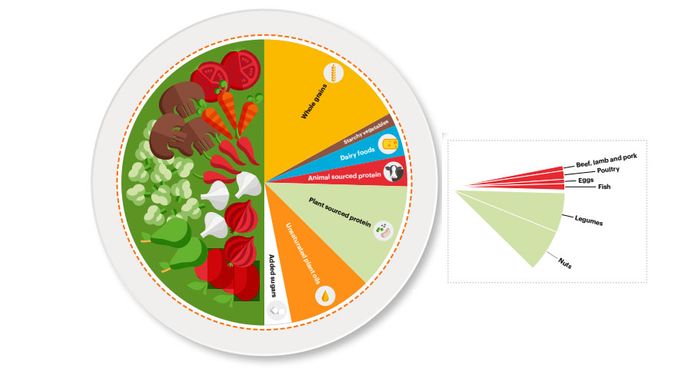
HOW TO PLAN YOUR MEALS FOR PLANETARY HEALTH
“Food is the single strongest lever to optimize human health and environmental sustainability on Earth.” Eat-Lancet Summary Report
The first step in taking action for better Planetary Health is changing type of food you put on your plate. By making some simple changes, you can plan all your meals for Planetary Health and make an even greater impact for the benefit of our environment.
As shown in the image above, a Meal for Planetary Health is rich in plant-based foods with modest amounts of sustainably-sourced animal proteins. Refined grains and low-quality meat proteins are two of the main drivers behind large-scale production of a few industrialized crops.
If we all made some slight changes in our eating habits and introduced a larger variety of plant foods and plant-based proteins, then we could collectively reduce the negative environmental impacts of industrial agriculture.
Currently, only 1 out of 10 adults is eating enough fruits and vegetables. To eat for Planetary Health, focus on filling half of your plate with vegetables and fruits, and the other half made of whole grains, plant-based proteins, healthy oils and some sustainably-sourced animal proteins. The average American is encouraged to double the daily amount of fruits and vegetables, and triple the daily amount of legumes and nuts, they eat.
Eating a variety of foods like this can meet the average, healthy American’s protein, carbohydrate, fiber, vitamin and mineral needs while limiting saturated fats, sodium, and carcinogenic nitrates found in processed meats.
Every time you choose to plan, prepare and share a Meal for Planetary Health, you are contributing to a kinder, more compassionate world and improving your health along the way.
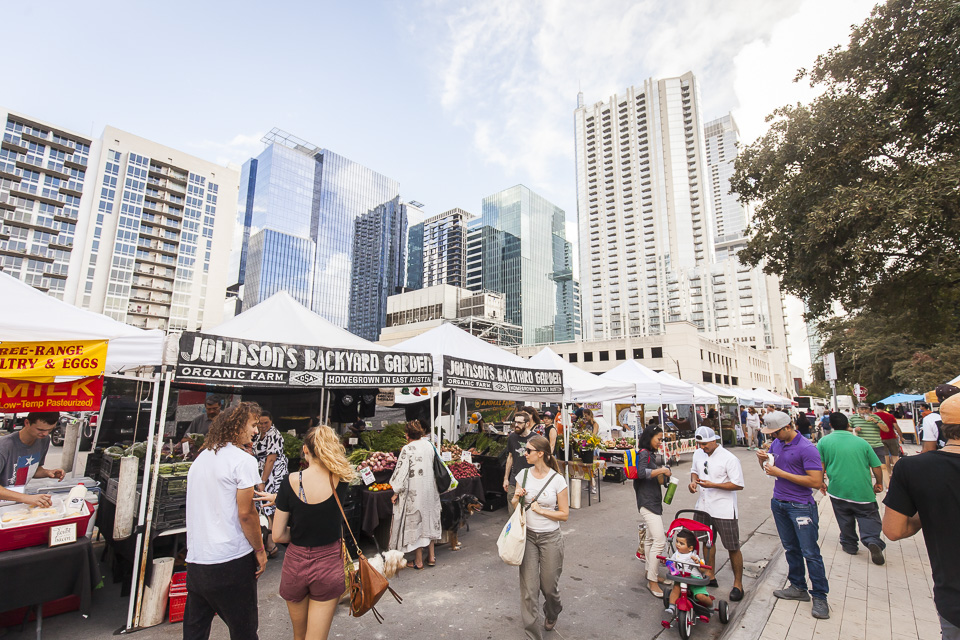 Our booth at SFC's Downtown Farmers' Market. Photo by Scott David Gordon.
Our booth at SFC's Downtown Farmers' Market. Photo by Scott David Gordon.
SHOP FROM LOCAL SUSTAINABLE FARMS TO PROTECT PLANETARY HEALTH
The next step in taking action for Planetary Health is buying your food from sustainable farms. Sustainable agriculture has the ability to heal and regenerate the land.
An increasing number of farms and ranches are moving to practices that mirror native ecosystems – they replenish the soil and pasture, protect sensitive watersheds, allow for natural animal behaviors, preserve and restore biodiversity, and minimize greenhouse gas emissions. And we are fortunate to have a wide variety of these farms and ranches right here in Central Texas.
Many of the farmers and ranchers at our SFC Farmers’ Markets are managing their pastures to holistically incorporate cows, chickens, pigs, goats and other livestock in their operations.
Responsibly rotating animals in dense herds or flocks has the power to transform landscapes into thriving ecosystems. It can re-build soil organic matter, grow healthy perennial grasses, increase water retention in the soil, repair waterways, restore pollinators and native bird species, pull carbon out of the atmosphere, and so much more.
When you support sustainable farms, you are supporting the livelihood of people who are working to protect our land. By shopping at your local farmers’ market, like our SFC Farmers’ Markets, you can buy your food directly from the farmer who grew it.
At a farmers’ market, you can talk to the farmer about how your food was raised - empowering you to make food choices for better Planetary Health. While you’re at the market, round out your grocery shopping with fresh produce and value-added items such as locally-made honey, bread, hummus, salsa, kimchi and fermentables, and more!
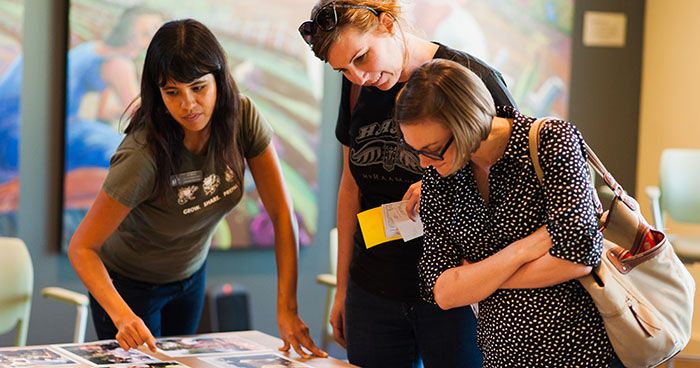
SYSTEMS LEVEL CHANGES TO PROTECT PLANETARY HEALTH
Individual choices matter to the future of our planet. But wide-spread systems change will be the key to facing climate change head-on.
The EAT Lancet Report offers the following strategies to achieve a fundamental, system-wide change:
1. Make healthy foods more available, accessible and affordable.
2. Intensify sustainable agriculture production.
3. Shift production towards a greater diversity of foods rather than higher volumes of a few crops largely grown to feed livestock.
4. Strong governance of land and oceans, in order to conserve and manage natural ecosystems, species-rich forests and the world’s oceans.
5. Minimize food loss and waste.
At Sustainable Food Center we are - alongside many regional, statewide, and national partners - actively working on strategies 1 and 2 listed above. We are also building new programs to support and celebrate the hard work, passion, and skill of sustainable farmers and ranchers in Central Texas. As we move into the future with our new vision, we hope to make big strides on systems-level change here in Texas.





 0 ITEMS IN CART
0 ITEMS IN CART 
